
Article Summary: Hawaii Landmarks
Hawaii Landmarks. More Than Just Parks has 15 incredible must-see sites for you to visit.
There’s so much more to this exciting place than Hawaii 5-0. In this article, we’ll familiarize you with the incredible landmarks located in The Aloha State.
We’ve got incredible places, iconic memorials, fascinating museums, epic monuments and so much more.
We’re going to give you our list of the Top 15 Landmarks In Hawaii.
So, What Is A Landmark?
Well, it’s a place of “a special character or special historical or aesthetic interest or value as part of the development, heritage, or cultural characteristics of a city, state, or nation.”
Why visit these places? Because landmarks connect us to the past. Through visiting these wonderful places where history occurred we find our roots. It allows us to feel like we are a part of something much bigger than ourselves.
And, speaking of history, did I mention that I taught the subject? I spent a lifetime teaching about the history behind many of these amazing sites. Then I got to see them firsthand. And now I’m sharing the fascinating stories of these places with you. It doesn’t get any better than that!
So, without further ado, let’s dive in.
Table of Contents: Hawaii Landmarks
Hawaii Landmarks
Some Fascinating Facts About Hawaii
- Unique Location: Hawaii is the only state in the United States that is entirely composed of islands. It is an archipelago of 137 volcanic islands, with the eight main islands being Hawaii (also known as the Big Island), Maui, Oahu, Kauai, Molokai, Lanai, Niihau, and Kahoolawe.
- Active Volcanoes: Hawaii is home to one of the most active volcanoes in the world, Kilauea, located on the Big Island. It has been erupting continuously since 1983, making it one of the longest-lasting volcanic eruptions in recorded history.
- Endemic Species: Due to its isolation, Hawaii is known for its unique and diverse ecosystem. Approximately 90% of the plant and animal species found in Hawaii are endemic, meaning they are found nowhere else in the world. The islands are particularly renowned for their colorful array of tropical fish, sea turtles, and birds such as the Hawaiian honeycreeper.
- Hula and Ukulele: Two iconic cultural symbols associated with Hawaii are the hula dance and the ukulele. Hula is a traditional Polynesian dance form that tells stories through rhythmic movements and gestures. The ukulele, a small guitar-like instrument, was introduced to Hawaii by Portuguese immigrants and has since become synonymous with Hawaiian music.
- Aloha Spirit: The concept of “aloha” is deeply ingrained in Hawaiian culture. Beyond its common meaning of “hello” and “goodbye,” aloha encompasses a philosophy of compassion, respect, and love for others and the environment. The Aloha Spirit Law, a state law in Hawaii, requires individuals to treat others with aloha and maintain harmony in the community.
- Pearl Harbor: Hawaii is home to Pearl Harbor, a historic naval base that was attacked by the Japanese in 1941, drawing the United States into World War II. Today, Pearl Harbor is a National Historic Landmark and houses several memorials, including the USS Arizona Memorial, honoring the lives lost during the attack.
- Surfing Capital: Hawaii is renowned as the birthplace of modern surfing. The islands offer world-class surf breaks, attracting surfers from around the globe. The North Shore of Oahu, in particular, is famous for its massive winter waves, hosting prestigious surfing competitions like the Vans Triple Crown of Surfing.
- Rainforests and Waterfalls: The islands of Hawaii are blessed with lush rainforests and breathtaking waterfalls. On the island of Kauai, the Na Pali Coast is known for its dramatic cliffs, deep valleys, and cascading waterfalls, creating a mesmerizing landscape.
- Astronomical Observatories: Mauna Kea, a dormant volcano on the Big Island, is home to some of the world’s most advanced astronomical observatories. Its high elevation, clear skies, and minimal light pollution make it an ideal location for stargazing and scientific research.
- Multicultural Melting Pot: Hawaii is a true melting pot of cultures and ethnicities. The state has a rich blend of Native Hawaiian, Asian, Pacific Islander, and Western influences. This diversity is reflected in the local cuisine, festivals, and traditions, creating a vibrant and multicultural society.
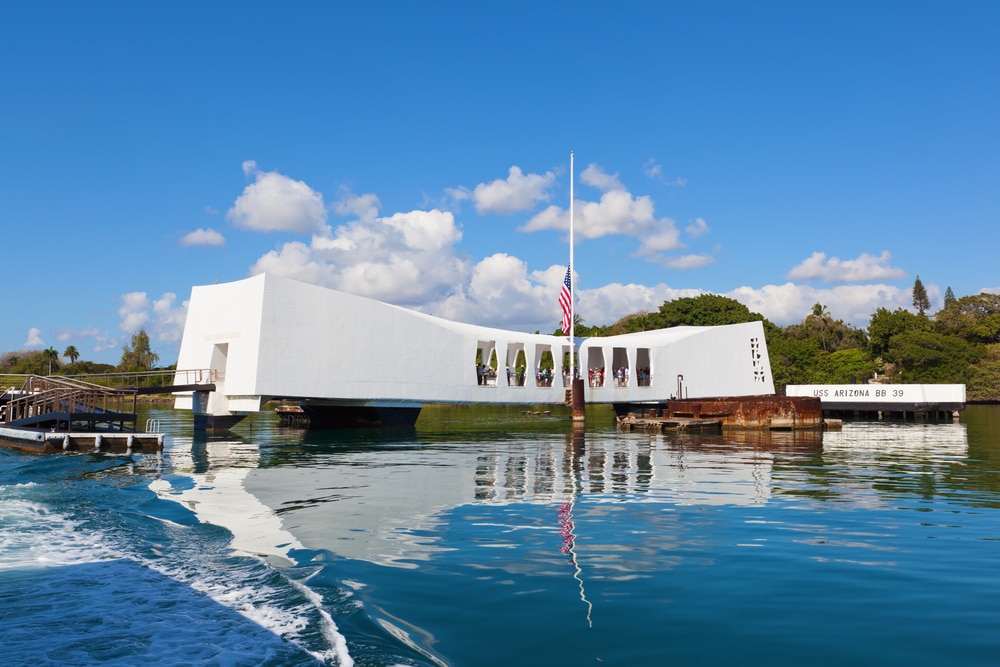
Top 15 Hawaii Landmarks
15. Kīlauea Lighthouse
World-class beaches, pristine rainforests, and sizzling volcanoes are just a few things that make Hawaii a happening hotspot for tourists. Every Hawaiian Island has its own draw, making this state one that is filled with adventure and luxury no matter which way you turn.
And, speaking of adventure, More Than Just Parks has the Top 15 Hawaii Landmarks for you to visit. A great place to start is at #15 on our list. It’s Kīlauea Lighthouse.
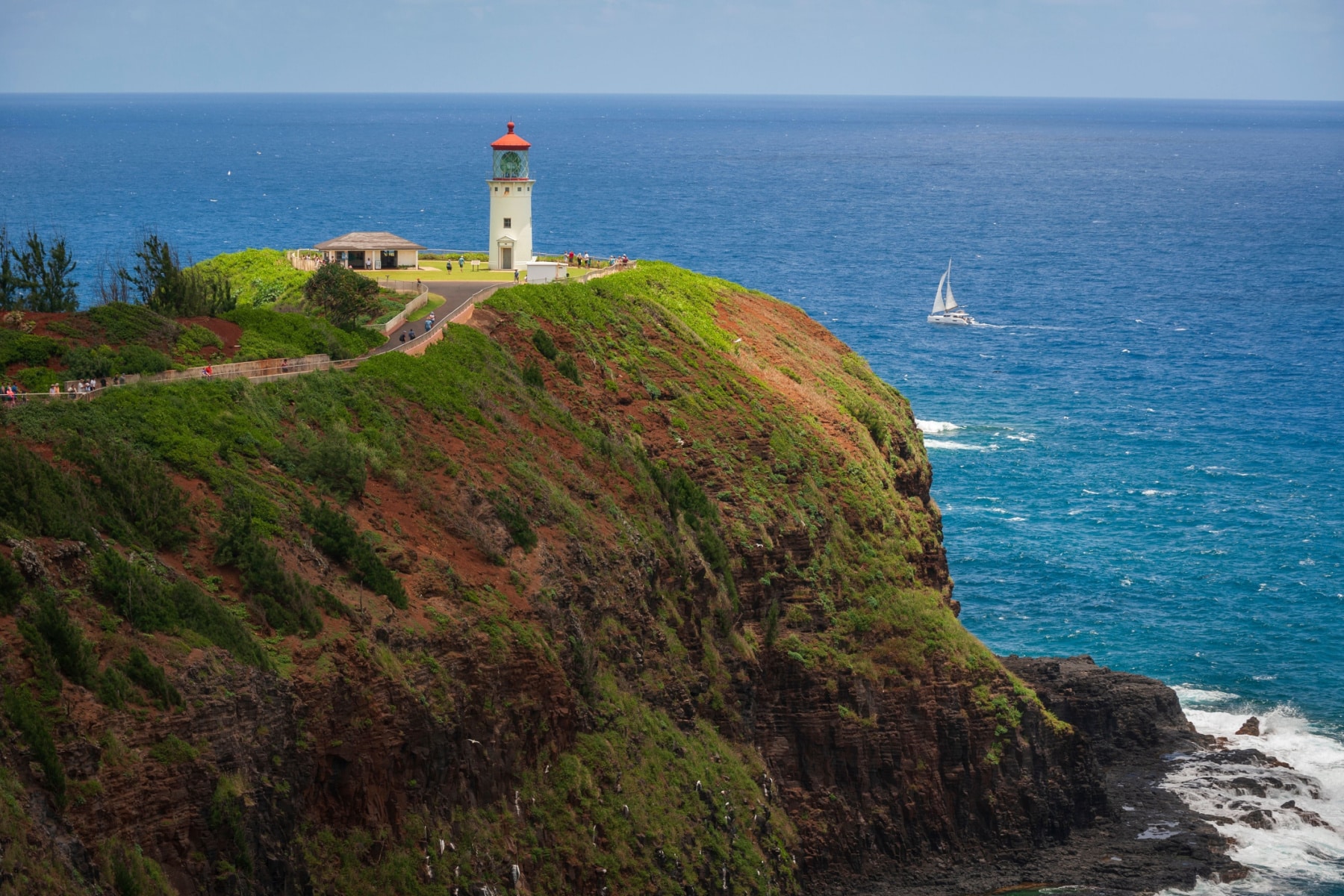
A Short History
The Kīlauea Lighthouse was constructed in 1913 to guide ships navigating the treacherous waters off Kauai’s coast. It was designed by the engineering firm of W.G. Irwin & Company and built using reinforced concrete. The lighthouse stands at a height of 52 feet and features a distinctive red and white color scheme.
The lighthouse played a crucial role in guiding ships traveling through the Pacific Ocean. Its powerful beam could be seen from a distance of 22 nautical miles, providing a vital navigational reference point for mariners. In the early 20th century, when ships were the primary mode of transportation, the Kīlauea
In 1976, the Kīlauea Lighthouse was automated, ending the need for a resident lighthouse keeper. The Coast Guard continued to operate the lighthouse until 1984 when it was decommissioned. The light was then replaced with a modern navigational aid located nearby.
Following the lighthouse’s decommissioning, the surrounding area was designated as the Kīlauea Point National Wildlife Refuge in 1985. The refuge was established to protect and restore native seabird populations, including the endangered Hawaiian goose, or Nene, and various species of seabirds.
Kīlauea Lighthouse Today
In recent years, the Kīlauea Lighthouse underwent extensive restoration efforts. The U.S. Fish and Wildlife Service, in collaboration with community organizations, restored the lighthouse and surrounding structures, including the keeper’s quarters. The restoration aimed to preserve the historical integrity of the site while also providing educational opportunities for visitors.
Today, the Kīlauea Lighthouse and the surrounding wildlife refuge are open to the public. Visitors can enjoy panoramic views of the Pacific Ocean, observe the diverse seabird populations, and learn about the history and conservation efforts of the area. The lighthouse itself is not open for public entry, but the surrounding grounds offer interpretive displays and walking trails for exploration.
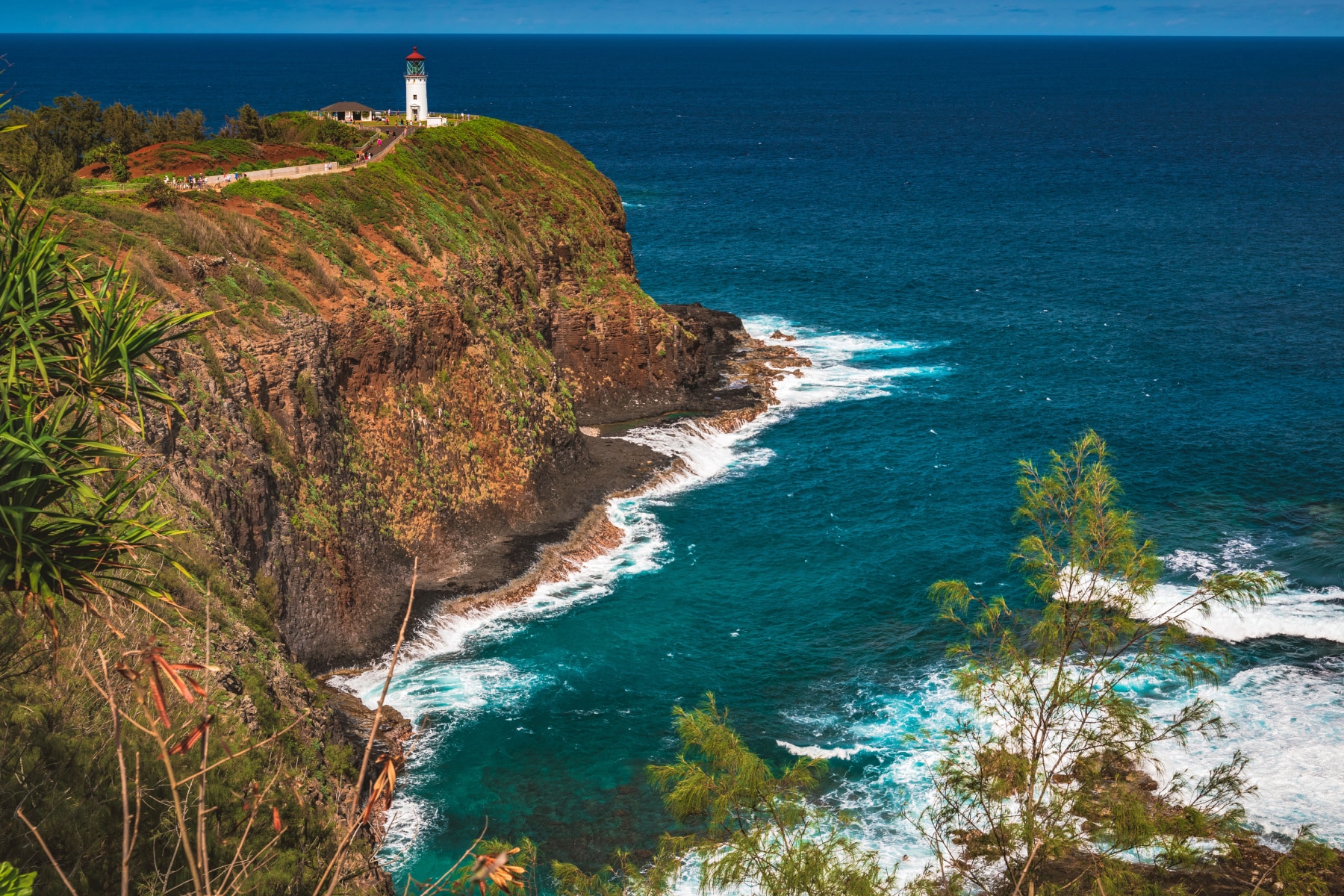
14. Dole Plantation
Our next Hawaii landmark is one of Oahu’s most popular visitor attractions and welcomes more than one million visitors a year. Dole Plantation provides enjoyable activities for the entire family, including the Pineapple Express Train Tour, the Plantation Garden Tour, and the Pineapple Garden Maze.
At #14 on our list of the Best Hawaii Landmarks is the Dole Plantation.
The Dole Plantation traces its roots back to 1900 when James Dole, a young entrepreneur from Massachusetts, established the Hawaiian Pineapple Company. He saw the potential for growing pineapples in the fertile volcanic soil of Hawaii and purchased land in Wahiawa, Oahu, to cultivate the fruit.
As the demand for Hawaiian pineapples grew, so did the Hawaiian Pineapple Company. James Dole implemented innovative farming techniques, such as using canned pineapples for widespread distribution and investing in infrastructure and transportation to streamline the production process.
The Dole Plantation was the operational center for the Hawaiian Pineapple Company. It served as a hub for pineapple cultivation, processing, and canning. The plantation encompassed vast acres of land dedicated to pineapple fields and included facilities for harvesting, sorting, and packing the fruit.
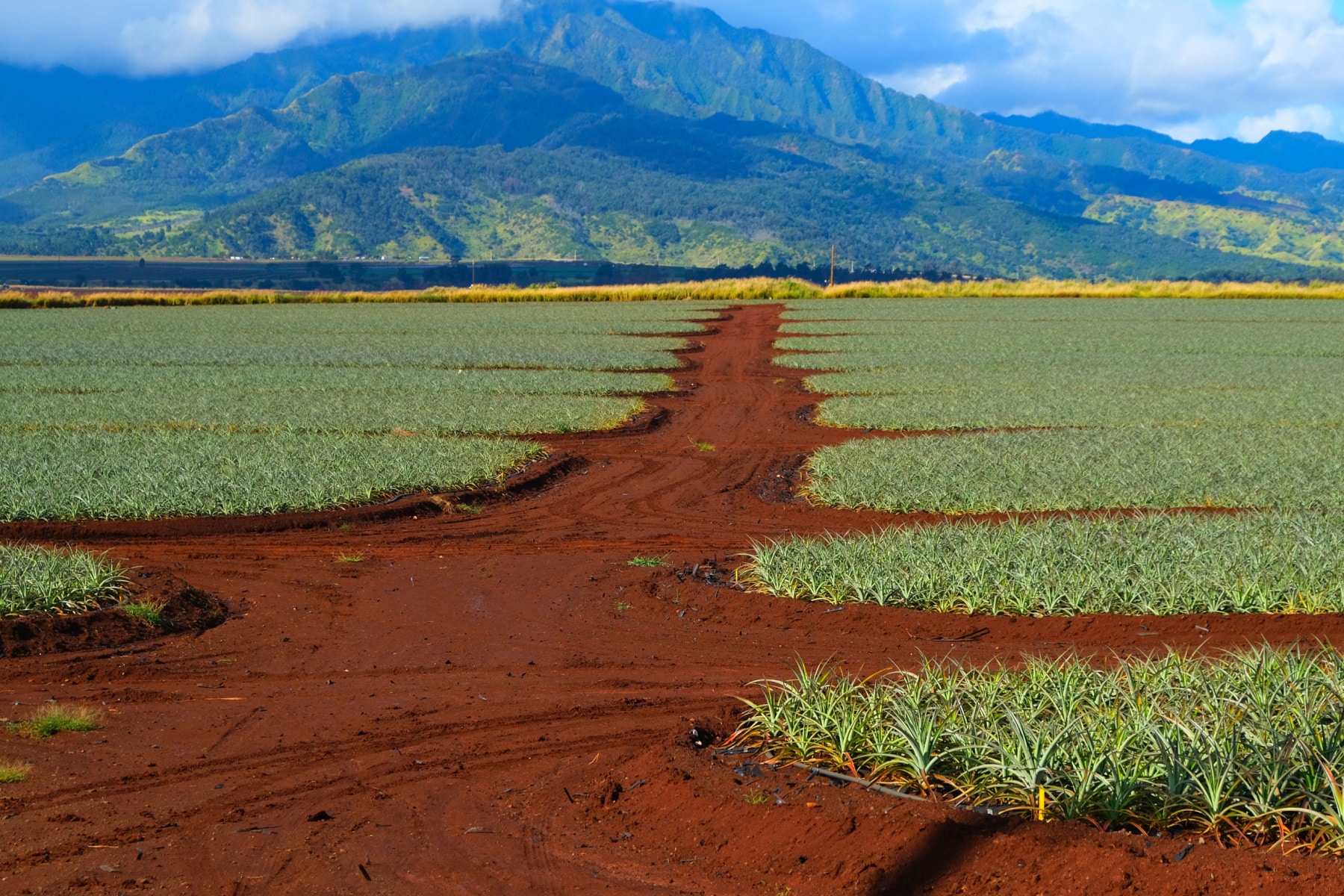
An Industry Leader
Under James Dole’s leadership, the Hawaiian Pineapple Company became the largest pineapple producer in the world. The company’s success played a significant role in establishing Hawaii as a leading global pineapple supplier and contributed to the growth of the island’s agricultural economy.
In 1961, the Hawaiian Pineapple Company changed its name to the Dole Food Company to reflect its diversification into other agricultural products. While pineapple remained a prominent part of its business, Dole expanded its operations to include various fruits, vegetables, and processed food products.
In 1989, the Dole Plantation opened its doors to the public as a visitor attraction. It aimed to showcase the history and significance of the pineapple industry in Hawaii while providing educational and entertaining experiences for visitors.
The Dole Plantation offers a range of attractions and activities for visitors. The Pineapple Express Train Tour takes guests on a narrated journey through the plantation, providing insights into pineapple cultivation and the history of the industry. The Plantation Garden Tour offers a leisurely walk through various gardens, including a pineapple garden and a tropical fruit pavilion. Visitors can also explore the Plantation Country Store, which offers a variety of pineapple-themed souvenirs and food products.
13. Honolulu Museum of Art
We move from pineapples to art. At #13 on our list of the Best Hawaii Landmarks is the Honolulu Museum of Art.
The museum was founded in 1922 as the Honolulu Academy of Arts by Anna Rice Cooke, a local philanthropist and art collector. Over the years, it has grown and evolved, expanding its collection and scope of exhibitions.
The Honolulu Museum of Art boasts a vast and varied collection of over 50,000 artworks from different cultures and periods. It encompasses Asian, European, American, and Pacific art, as well as contemporary and modern art. The collection features paintings, sculptures, prints, photographs, textiles, ceramics, and more.
The museum’s Asian art collection is particularly noteworthy, with a focus on works from Japan, China, Korea, and Southeast Asia. It includes ancient and contemporary pieces, such as Japanese woodblock prints, Chinese jade and porcelain, Korean ceramics, and Buddhist sculptures.
The museum’s European and American art collection encompasses paintings, sculptures, and decorative arts from various periods. It includes works by renowned artists such as Vincent van Gogh, Claude Monet, Pablo Picasso, Georgia O’Keeffe, and Andy Warhol, among others.

Honolulu Museum of Art with former name “Honolulu Academy of Arts” — entrance veranda and gardens designed by Bertram Goodhue in the Hawaiian and Spanish Colonial Revival styles | Courtesy of Wikimedia Commons
Exhibitions & Programs
The museum presents rotating exhibitions that explore various themes, artists, and art movements. These exhibitions often include loaned artworks from other institutions, providing visitors with diverse and thought-provoking experiences. The museum also offers educational programs, lectures, workshops, and performances to engage the community and enhance art appreciation.
The Honolulu Museum of Art is home to the Doris Duke Theater, a venue dedicated to showcasing film, performing arts, and cultural events. It presents a wide range of films, from classics to independent productions, as well as live performances, including dance, theater, and music.
The museum operates a second location, called Spalding House or the Honolulu Museum of Art Spalding House, situated in Makiki Heights. This site offers a different perspective on contemporary art and features outdoor sculptures and a scenic garden.
Polynesian Cultural Center
Our next landmark is Hawaii’s #1 visitor attraction, has 6 island villages representing the unique island cultures of Hawaii, Fiji, Aotearoa (New Zealand), Samoa, Tahiti, and Tonga. Set on 42 acres along Oahu’s North Shore, it has a lagoon that hosts daily canoe tours. Welcome to the Polynesian Cultural Center.
The Polynesian Cultural Center was established in 1963 by The Church of Jesus Christ of Latter-day Saints (LDS Church) with the purpose of preserving and promoting the Polynesian cultures of Hawaii, Samoa, Tonga, Fiji, Tahiti, and Aotearoa (New Zealand). It serves as a nonprofit organization and a popular tourist destination.
The centerpiece of the Polynesian Cultural Center is its collection of six distinct Polynesian villages representing different island cultures. Visitors can explore these villages and interact with native performers who demonstrate traditional arts, crafts, music, dance, and storytelling. Each village provides a unique glimpse into the customs, history, and way of life of the respective Polynesian culture.
One of the major highlights at the Polynesian Cultural Center is the daily canoe pageant, known as the “Huki: A Canoe Experience.” The pageant features skilled Polynesian performers paddling traditional canoes, accompanied by songs and chants that share stories from Polynesian mythology and history.

Polynesian Cultural Center | Courtesy of Wikimedia Commons
“Hā: Breath of Life”
The Polynesian Cultural Center presents an evening theatrical show called “Hā: Breath of Life.” This spectacular performance combines dance, music, fire-knife dancing, and special effects to portray the universal themes of love, family, and the circle of life. The show offers a dynamic display of Polynesian cultural expressions and storytelling.
The Polynesian Cultural Center offers various activities and hands-on workshops where visitors can learn about Polynesian arts and crafts. These include traditional canoe rides, ukulele and hula lessons, coconut husking demonstrations, lei-making, and Samoan fire knife dancing workshops.
Guests at the Polynesian Cultural Center can enjoy traditional Polynesian cuisine at one of the center’s luau feasts. The Ali’i Luau offers an immersive dining experience with a buffet of Hawaiian and Polynesian dishes, accompanied by live entertainment. There are also casual dining options available, including a Polynesian-themed food court.
The Polynesian Cultural Center is committed to environmental sustainability and cultural preservation. It actively participates in ecological initiatives and aims to preserve and perpetuate the traditions and practices of Polynesian cultures for future generations.
11. Honolulu Zoo
Our next Hawaii landmark is the only zoo in the United States to be established by grants made by a sovereign monarch. At #11 on our list of the Best Hawaii Landmarks is the Honolulu Zoo.
The Honolulu Zoo was established in 1877 and is one of the oldest zoos in the United States. It began as a small collection of animals in the Kapiolani Park area and has since grown into a significant zoological institution.
The Honolulu Zoo is dedicated to the conservation of wildlife and plays an active role in global conservation efforts. It participates in breeding programs for endangered species, conducts research, and supports initiatives for animal welfare. The zoo also offers educational programs, guided tours, and interactive exhibits to raise awareness about wildlife conservation and environmental sustainability.
The Honolulu Zoo features a special area called the Keiki Zoo, designed for younger visitors. This interactive children’s zoo allows kids to have hands-on experiences with domestic animals, feed farm animals, and learn about animal care and conservation.

Special Exhibits & Events
The zoo regularly hosts special exhibits and seasonal events to enhance the visitor experience. These may include temporary exhibits focusing on specific animal species or themed events like the annual “Zoo Boo” Halloween celebration. Additionally, the zoo offers educational workshops, summer camps, and birthday party packages.
Alongside its animal collection, the Honolulu Zoo boasts an extensive botanical collection. The grounds feature a diverse range of tropical plants, flowers, and trees that contribute to the overall ambiance and natural beauty of the zoo.
The zoo provides accessible pathways and facilities to accommodate visitors with disabilities. It offers amenities such as restrooms, picnic areas, a gift shop, and various food and beverage options. Strollers and wheelchairs are available for rent.
The Honolulu Zoo is situated in the Waikiki neighborhood, making it easily accessible to both residents and tourists. It is located near other popular attractions such as Kapiolani Park, the Waikiki Aquarium, and Diamond Head State Monument, offering visitors the opportunity to explore the surrounding area.
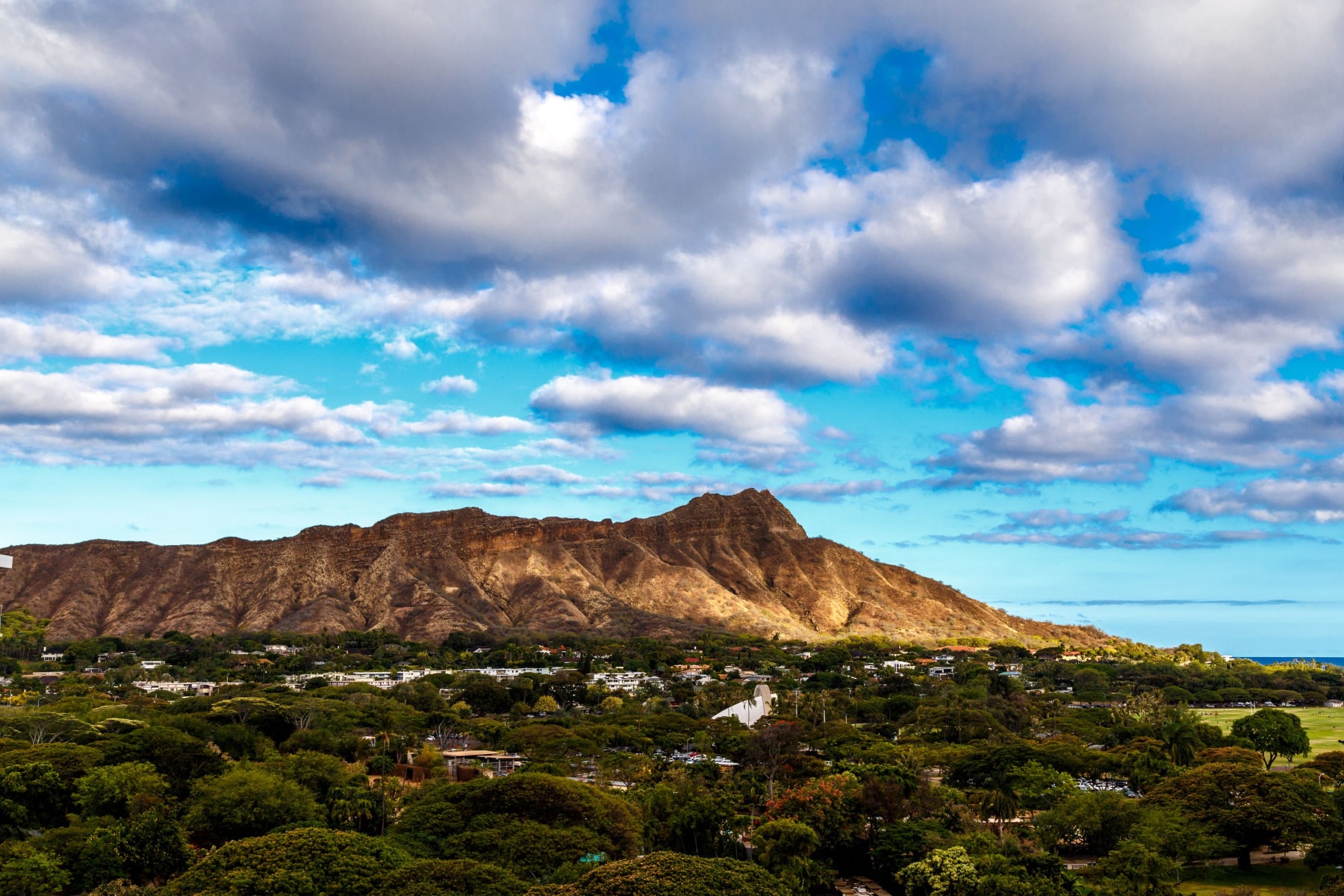
Top 10 Hawaii Landmarks
10. Pu’uhonua o Honaunau National Historical Park
Were on to our Top 10 Hawaii Landmarks. At #10 on our list is Pu’uhonua o Honaunau National Historical Park.
It was established in the 1960s to preserve and interpret the cultural and historical resources of the Honokohau Settlement, an ancient Hawaiian village that was once home to the ancient Hawaiian aquaculture fishponds, petroglyphs, house site platforms, and sites with religious significance.
It’s located on the Kona coast of Hawaii Island, and it is considered one of the most important archaeological sites in the Hawaiian Islands. The park is home to several ancient Hawaiian temples, including the Temple of the Great Image, which is a large heiau (temple) that was used for both religious and political purposes.
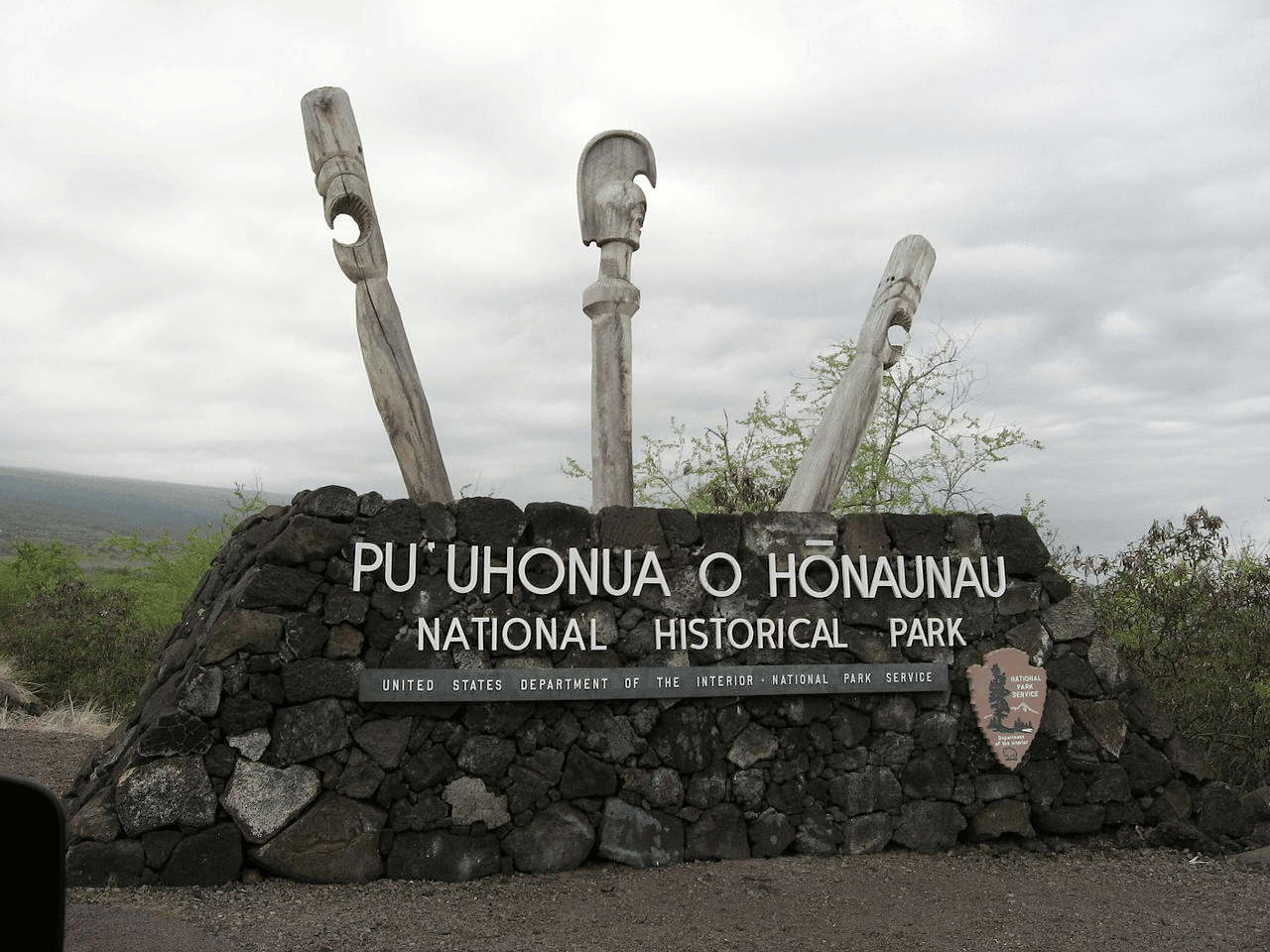
The Park Features Hawaiian Fishponds
The park also features the ancient Hawaiian fishponds, which were used for raising fish and other aquatic life, and the petroglyphs, which are ancient carvings in rock that depict Hawaiian deities and other important cultural symbols.
In addition to the historical and archaeological resources, the park also offers visitors the opportunity to explore the natural beauty of the area, including the lush tropical vegetation, the beaches and the sea cliffs. Visitors can take guided tours and ranger-led programs, which offer an in-depth look at the park’s history and cultural significance.
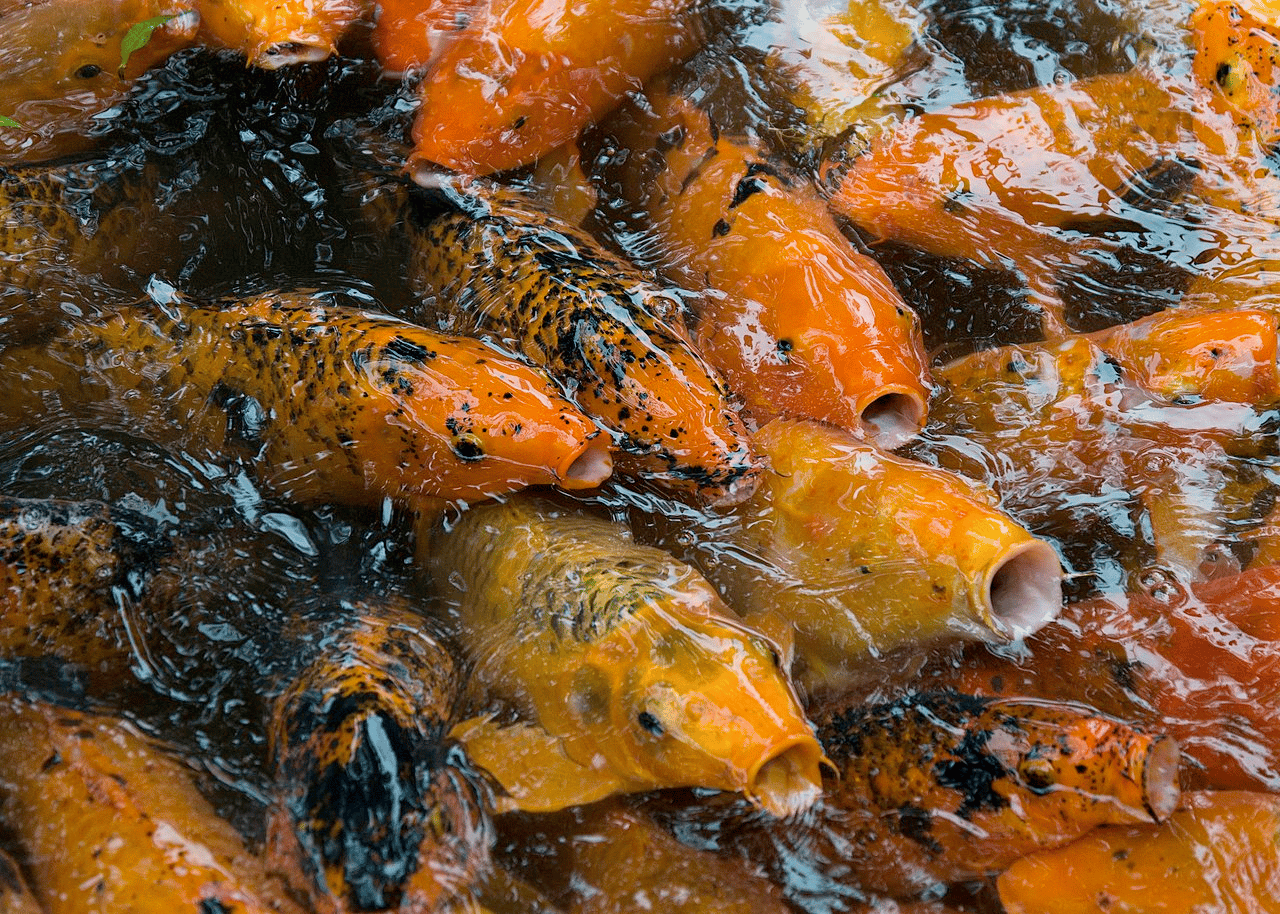
9. Pu’u O Mahuka Heiau
At #9 on our list of the Best Hawaii Landmarks is Pu’u O Mahuka Heiau.
Pu’u O Mahuka Heiau is an ancient Hawaiian temple located on the island of Oahu, in the community of Pupukea, on the North Shore. The heiau is one of the largest and most significant temples in Hawaii, and it dates back to the 17th century.
The name Pu’u O Mahuka means “Hill of Escape” in the Hawaiian language, and it is believed to refer to the heiau’s use as a place of refuge during times of warfare. The temple is situated on a hill overlooking Waimea Bay and the surrounding countryside.
Pu’u O Mahuka Heiau was dedicated to the war god Kuka’ilimoku, as well as other Hawaiian gods and goddesses. The temple was constructed using large basalt stones that were stacked without mortar. The site contains several walls, platforms, and altars, including a large stone platform that was used for ceremonial purposes.
The heiau was a place of great spiritual significance for the Hawaiian people, and it was used for various religious ceremonies and rituals, including offerings, sacrifices, and prayers. The temple was also used as a place of political and social gathering, where chiefs and priests would discuss important matters and make decisions.
Today, Pu’u O Mahuka Heiau is a popular tourist attraction and a designated National Historic Landmark. The heiau is managed by the Hawaii Department of Land and Natural Resources, and visitors can explore the site and learn about its rich history and cultural significance.
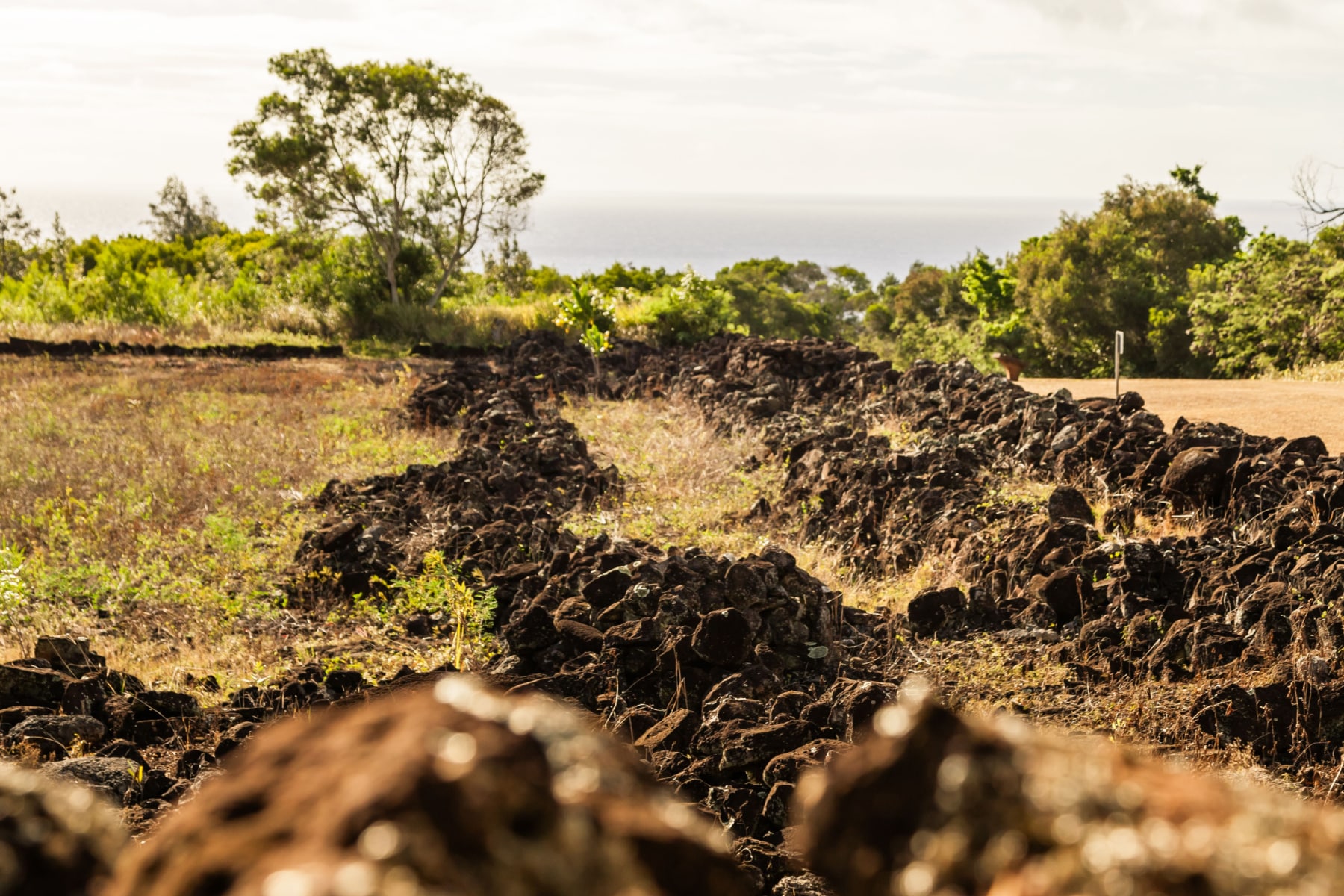
8. Shangri La Museum of Islamic Art, Culture & Design
At #8 on our list of the Best Hawaii Landmarks is the Shangri La Museum of Islamic Art, Culture & Design.
The Shangri La Museum of Islamic Art, Culture & Design is located in Honolulu, Hawaii. It’s dedicated to promoting understanding and appreciation of Islamic art and culture.
The museum is situated in a stunning setting overlooking the Pacific Ocean, and it was once the home of American heiress and philanthropist Doris Duke.
The museum’s collection features over 3,500 objects from the Islamic world, including ceramics, textiles, metalwork, jewelry, and furniture. The collection spans over 1,400 years of Islamic art, from the 7th to the 20th centuries, and includes works from Iran, Turkey, Syria, Egypt, Spain, India, and Central Asia.
One of the highlights of the collection is a room of 18th-century Syrian architecture and design, known as the Damascus Room. The room was originally part of a wealthy merchant’s home in Damascus and was acquired by Doris Duke in the 1950s. The room features intricate wooden carvings, colorful tilework, and other decorative elements.
In addition to the museum’s permanent collection, the Shangri La Museum hosts temporary exhibitions, lectures, and other events related to Islamic art and culture. The museum also offers guided tours of the house and gardens, as well as educational programs for students and teachers.
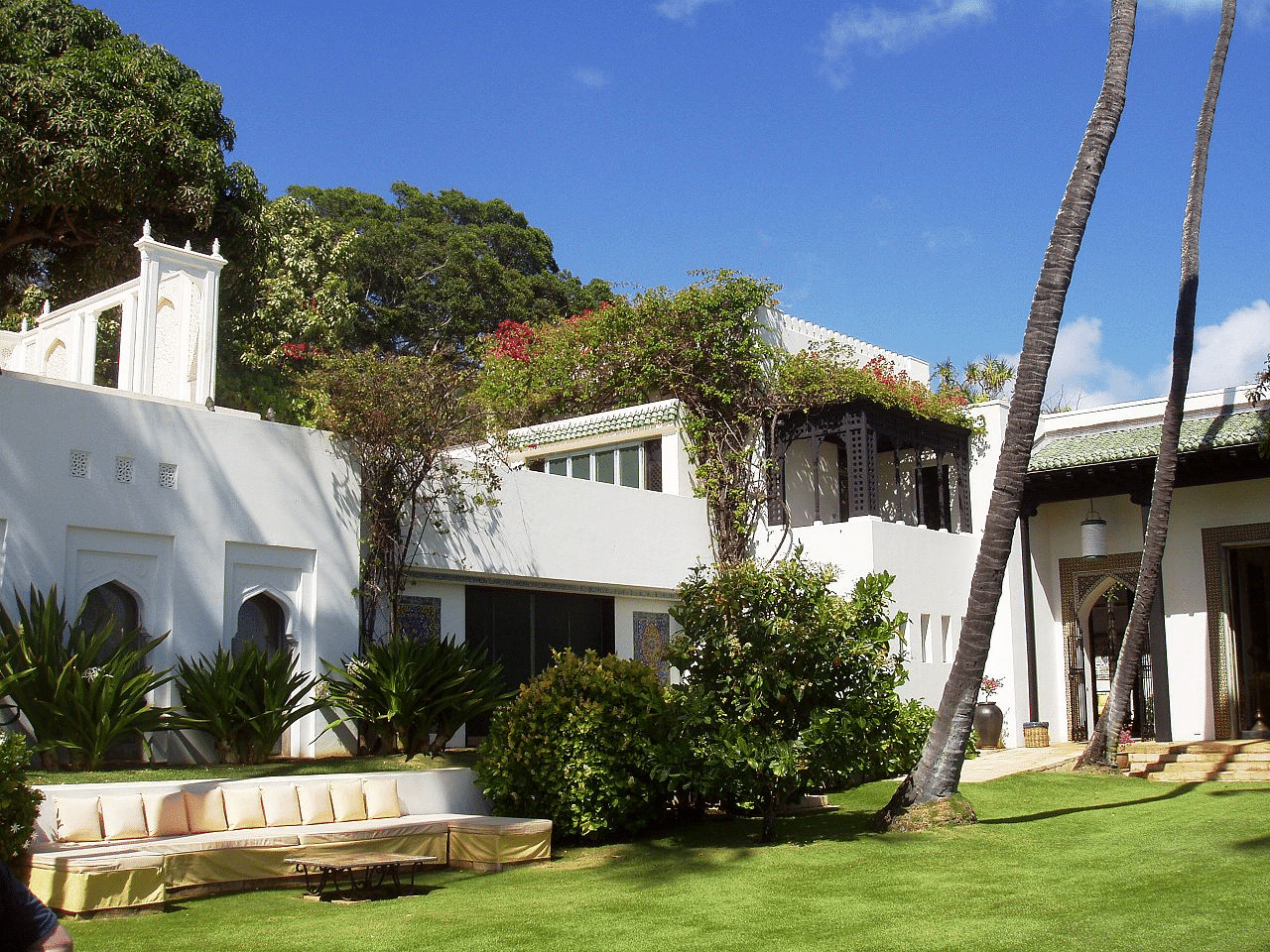
7. Kalaupapa National Historical Park
At #7 on our list of the Best Hawaii Landmarks is the Kalaupapa National Historical Park.
Kalaupapa National Historical Park is located on the island of Molokai in Hawaii. The park was established to commemorate the forced exile of over 8,000 people with leprosy (now known as Hansen’s disease) to the Kalaupapa Peninsula between 1866 and 1969.
The park includes the Kalaupapa Settlement, where the patients were sent to live, as well as the historic village of Kalawao, where the first settlements of people with leprosy were established.
In 1866, the Hawaiian government passed a law mandating the separation of people with leprosy from the general population. This led to the creation of the Kalaupapa Settlement, where people with the disease were sent to live in isolation. The patients were forced to leave their families and friends, and were not allowed to leave the settlement. They were also not permitted to marry or have children.
The settlement was run by the Catholic Church, which provided medical care and other services to the patients. Despite the harsh living conditions, the patients were able to create a vibrant community, with schools, churches, and other institutions.
In 1969, the Hawaiian government abolished the quarantine laws, and patients were no longer forced to live in the settlement. Today, the park serves as a reminder of the human rights abuses that occurred there, and as a tribute to the resilience and strength of the patients who were forced to live there.
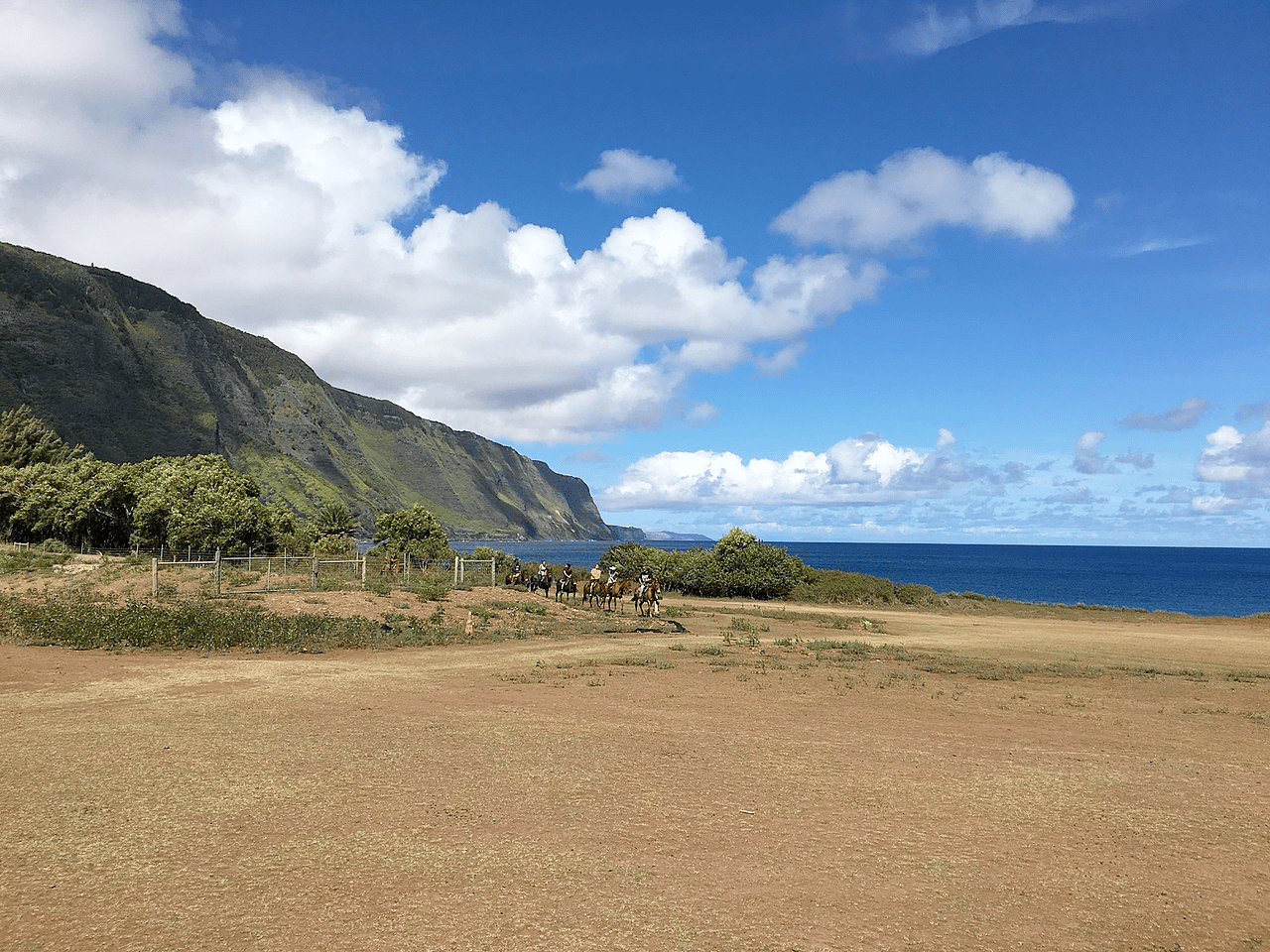
6. Historic Aloha Tower
Our next site is an iconic landmark tower that’s located in Honolulu. At #6 on our is the Aloha Tower.
It has played a significant role in the history of the state. The tower was completed in 1926 and was originally built as a lighthouse and a passenger terminal for the Honolulu Harbor.
At the time of its construction, the Aloha Tower was the tallest building in Hawaii, standing at 184 feet tall. It was designed by architects Arthur Reynolds and C.W. Dickey in a Hawaiian Gothic style, with a white concrete structure and a green tile roof. The tower’s clock, which is visible from miles away, was also an important feature for sailors and locals alike, as it would signal the arrival and departure of ships.
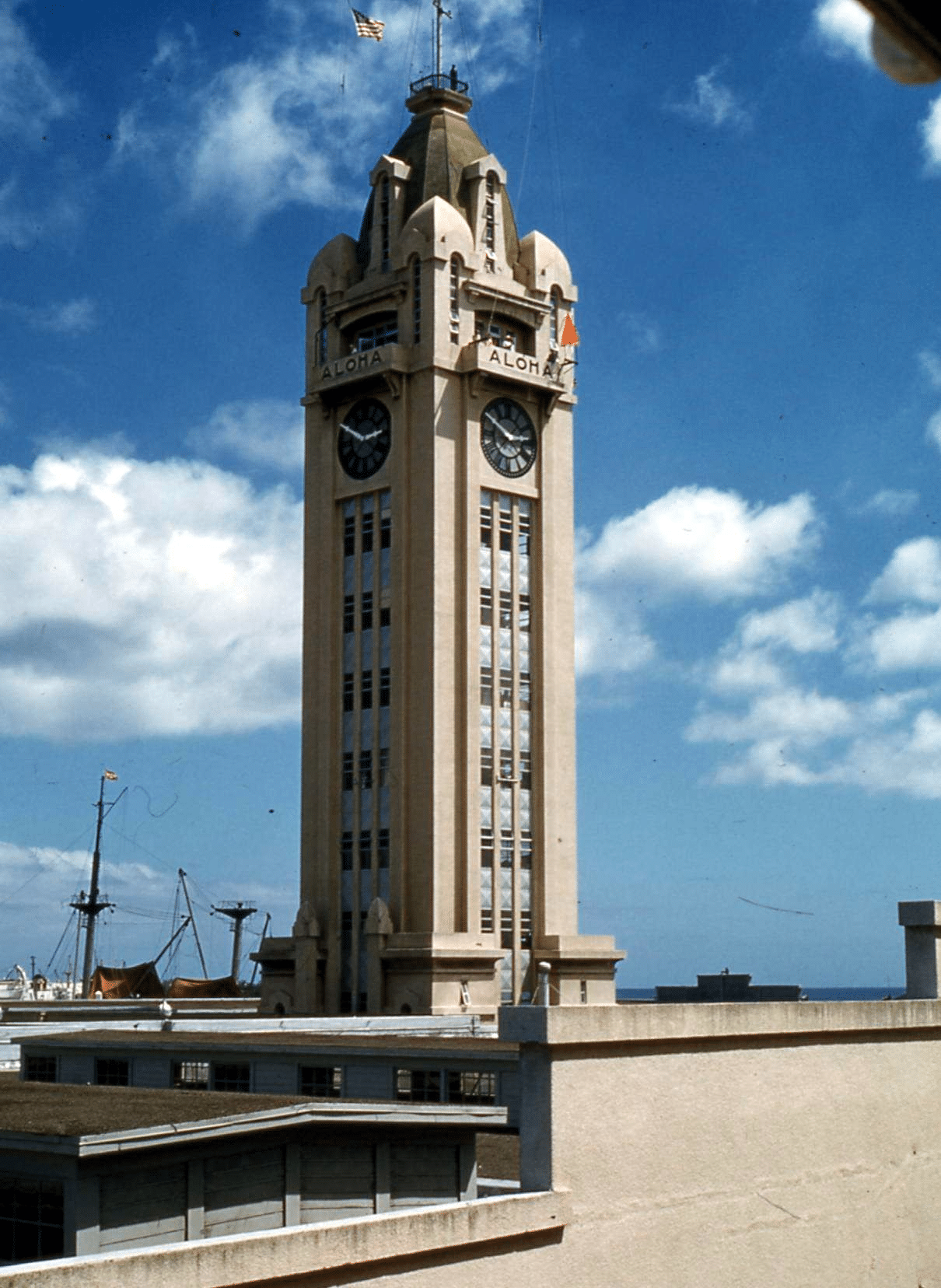
It Was An Important Gateway To Hawaii
In the early 20th century, the Aloha Tower was an important gateway to Hawaii, as it welcomed thousands of passengers arriving on steamships from the mainland United States and other parts of the world. The tower became a symbol of Hawaii’s hospitality and was often the first thing that visitors saw when arriving in Honolulu.
Over the years, the Aloha Tower has undergone several renovations and changes. In 1949, the tower’s lighthouse was decommissioned, and the tower was converted into office space for the University of Hawaii. In the 1970s, the tower was restored and became part of a shopping center and entertainment complex known as the Aloha Tower Marketplace.
Today, the Aloha Tower is still an important symbol of Hawaii’s maritime history and a popular tourist attraction. Visitors can take a guided tour of the tower, visit the observation deck for panoramic views of the harbor and the city, and explore the shops and restaurants at the Aloha Tower Marketplace.
Top 5 Hawaii Landmarks
5. National Memorial Cemetery of the Pacific
We’re on to the Top 5 Hawaii Landmarks. At #5 is the National Memorial Cemetery of the Pacific.
The National Memorial Cemetery of the Pacific, also known as the Punchbowl Cemetery, is a national cemetery located in Honolulu, Hawaii. The cemetery is situated in the Punchbowl Crater, which was formed by a volcanic eruption over 75,000 years ago.
The history of the cemetery dates back to 1948, when the United States Congress authorized the creation of a national cemetery in the Pacific region to honor the American military personnel who had died in World War II. The site in Punchbowl Crater was chosen due to its central location in the Pacific and its scenic beauty.
Construction of the cemetery began in 1949, and it was completed in 1951. The cemetery covers 112 acres and contains over 53,000 graves of military personnel from all branches of the United States Armed Forces, as well as from other countries, including Canada, France, and Australia.
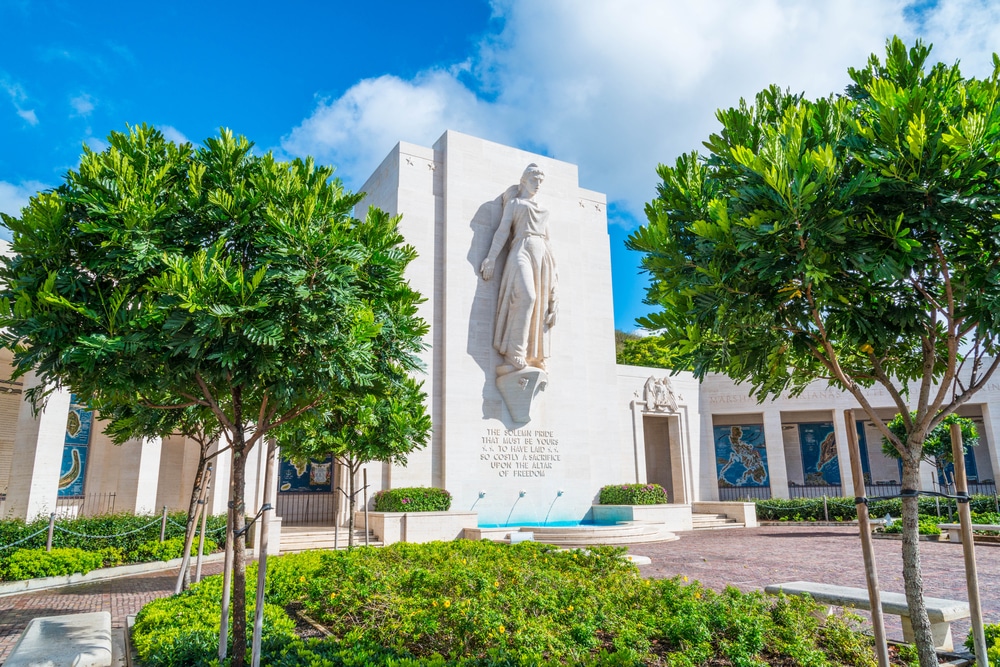
It’s Also Home To Several Monuments & Memorials
The cemetery is also home to several monuments and memorials, including the Honolulu Memorial, which honors over 28,000 American military personnel who were lost or buried at sea during World War II, the Korean War, and the Vietnam War.
The cemetery also features a memorial to the USS Arizona, which was sunk during the attack on Pearl Harbor in 1941.
The National Memorial Cemetery of the Pacific is an important symbol of the sacrifices made by American military personnel and a popular destination for visitors to Hawaii.
The cemetery is open to the public every day, and visitors can take a guided tour, pay their respects at the memorials and monuments, and attend the annual Memorial Day ceremony.

Things To See
Visitors can see the hallowed ground which is the resting place for more than 25,000 victims of three American Wars – World War II, Korean War and Vietnam War – this is truly the “Cemetery of Heroes.”
There are various beautiful mosaic displays providing information regarding World War II, The Korean War and The Vietnam War.
There is also a wall with the names of those who were never recovered from battle, a small chapel, and a guest book for visitors to sign.
The National Memorial Cemetery of the Pacific contains a memorial pathway that is lined with a variety of memorials that have been donated by various organizations and foreign governments to honor America’s veterans.
As of 2012, there were 74 such memorials throughout the National Memorial Cemetery of the Pacific—most commemorating service members of 20th-century wars, including those killed at Pearl Harbor.
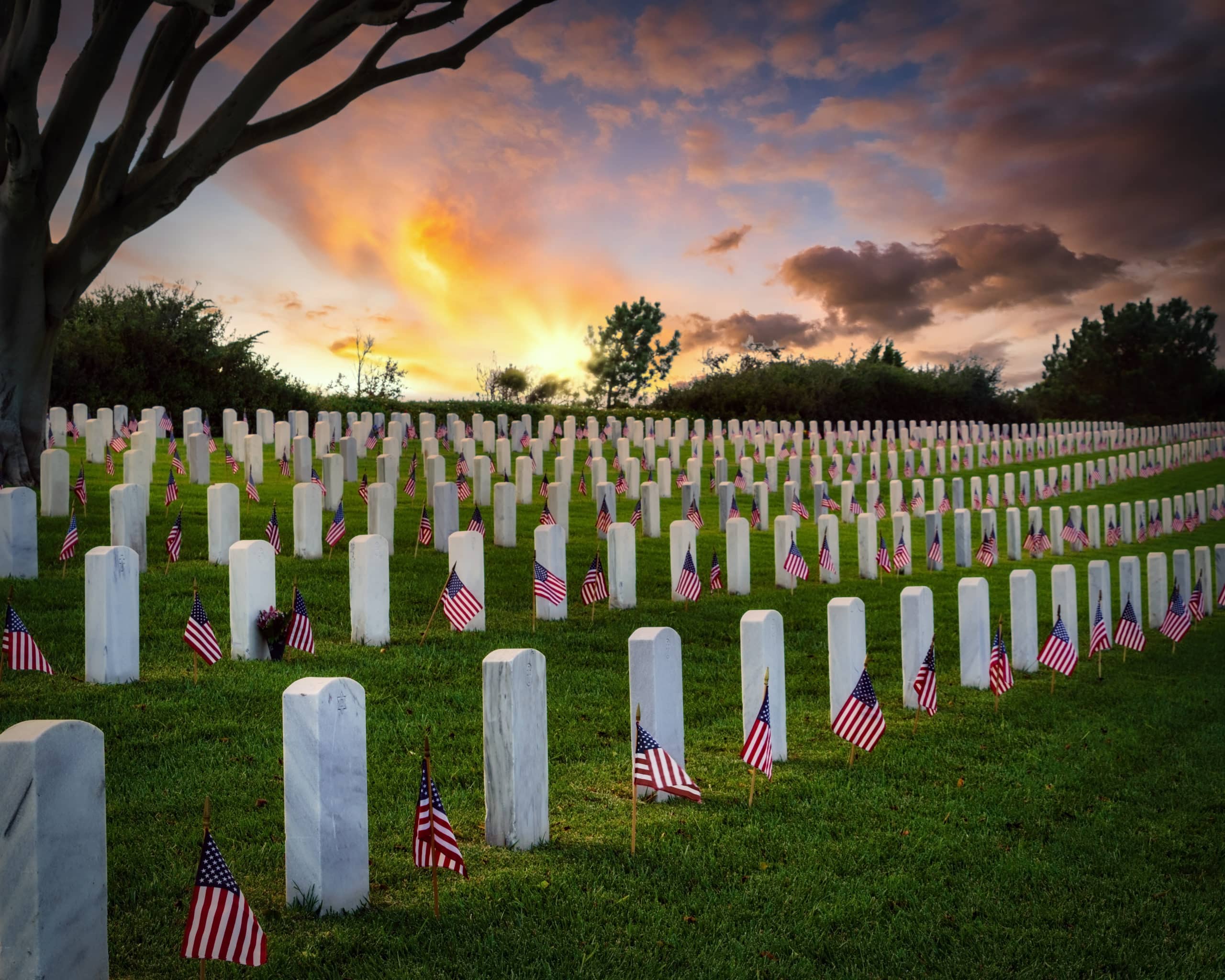
A Monument Honoring One Of The Challenger Astronauts
Of special note is a monument honoring Hawaii-born astronaut Ellison Onizuka, who perished aboard the Challenger space shuttle in 1986.
Also noteworthy are the Courts of the Missing, white stone tablets bearing the names of those missing in action from World War II.
To learn more about this special place, I recommend: Hill of sacrifice: The National Memorial Cemetery of the Pacific at Punchbowl by Doug Carlson.

4. Iolani Palace
We’re on the our “Final Four.” At #4 is a site which is a living restoration of a proud Hawaiian national identity and is recognized as the spiritual and physical multicultural epicenter of Hawaii. Welcome to Iolani Palace.
Built in 1882 by King Kalakaua, Iolani Palace was the home of Hawaii’s last reigning monarchs and served as the official royal residence and the residence of the Kingdom’s political and social life until the overthrow of the monarchy in 1893.
Registered as a National Historic Landmark since 1962 and the only official royal residence in the United States, the Palace is one of the most recognizable buildings in Hawaii.
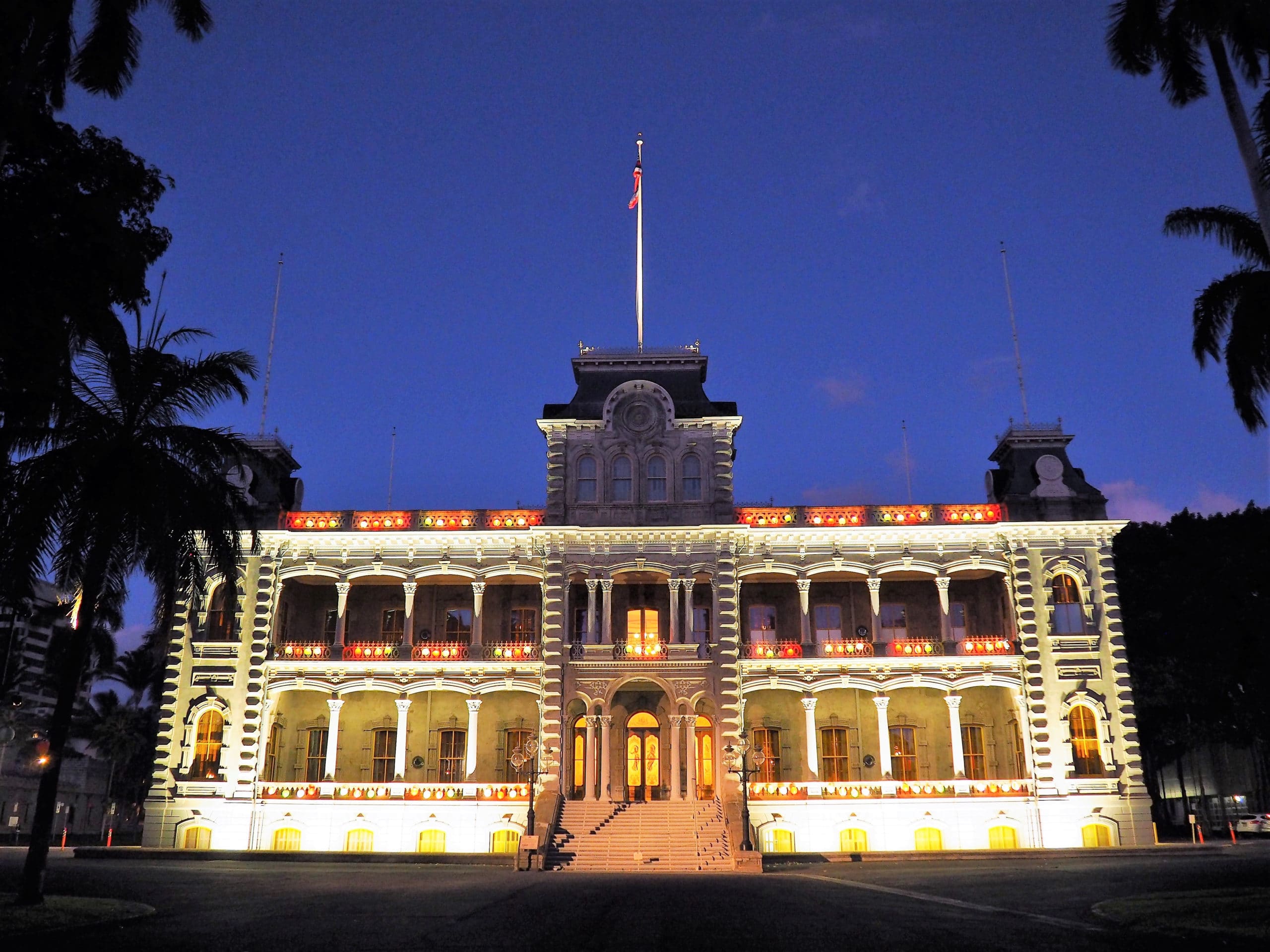
The Palace Tells The Story Of Hawaii’s Royalty
Meticulously restored to its former grandeur, Iolani Palace tells of a time when their Majesties, King Kalakaua and his sister and successor, Queen Liliuokalani walked the grand halls.
If you’re planning to visit then you should know that there are two popular tour options: a guided tour with a Palace Docent and a Self-Led Audio Tour.
Both options include a tour of the first and second floors of Iolani Palace followed by a self-guided exploration of the basement gallery exhibits.
Explore more with our specialty tours, such as Hawaii’s Royal Connection to Japan and Chamberlain’s Tour.
To learn more, I recommend: History of Iolani Palace by Albert Pierce.

Hawaii 5-0 & Iolani Palace
Now if you’re a fan of the television series Hawaii Five-0 then you might be interested to know that Hawaii Five-0’s offices are located inside Iolani Palace.
The Hawaii Five-0 Task Force (originally called State Task Force and Governor’s Task Force) Headquarters consists of the following:
- Steve’s Office: His desk contains the U.S. Flag, Hawaiian State Flag and Model ships.
- Danny’s Office: His desk has picture of Little Grace, a child’s drawing and a Toy police car.
- Chin’s Office
- Kono’s Office
- Interrogation Room: A cold, damp room shrouded in darkness which looks like a prison cell, it own has blue lighting from the ceiling. This is where Hawaii Five-0 take their suspects after arresting them during a case.
- Screening Room: This area was used to watch Steve’s High School football games and CHIPs marathon.
- Briefing Room: This is where the team usually gather to perform briefings on their latest case or get information. The area is also used to hold meetings and discuss information concerning their latest case. (Source: Fandom)
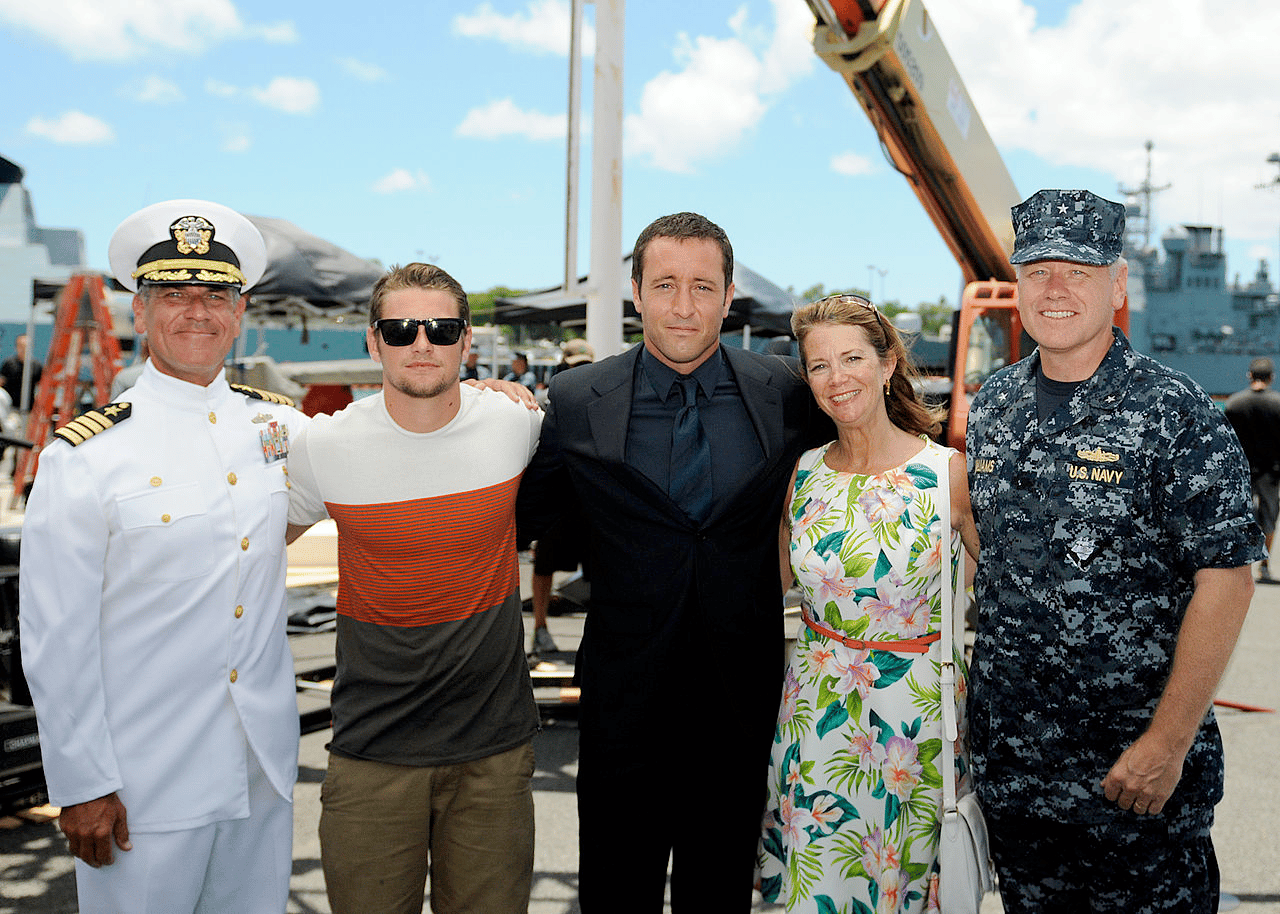
There’s Nothing Like The Original Hawaii Five-0
Now I don’t like to call attention to my age, but I was actually a big fan of the original Hawaii Five-0 series which aired on CBS for twelve season from 1968-1980.
The title of the show refers to Hawaii’s status as the 50th U.S. state; at the time of its premiere, Hawaii had officially been a U.S. state for only nine years.
Iolani Palace is shown as headquarters for the fictional Hawaii Five-O state police group in both the old series and the newer one which premiered in 2010.

Now Here’s Another Interesting Fact
You may not be familiar with Hawaii 5-0, but what about Magnum P.I.?
Magnum P.I. is the story of an ex-Navy SEAL who returns from Afghanistan and uses his military skills to become a private investigator in Hawaii.
Thomas Magnum is the name of the private investigator.
He lives on the estate of multi-millionaire author Robin Masters, run by Juliett Higgins, a former MI6 agent.
Did you know that this series was originally inspired by Hawaii 5-0? It turns out that CBS built a production studio in Hawaii to film episodes of the popular series which originally ran from 1968-1980.
Having those facilities in place, the network wanted to be able to continue using them when the 5-0 series went off of the air in 1980 so they launched a follow-up series which made references to the original Hawaii 5-0 series.
The show’s producers wanted to actually feature Steve McGarrett (Jack Lord) in an early episode with Thomas Magnum (Tom Selleck), but Lord was unwilling to participate.
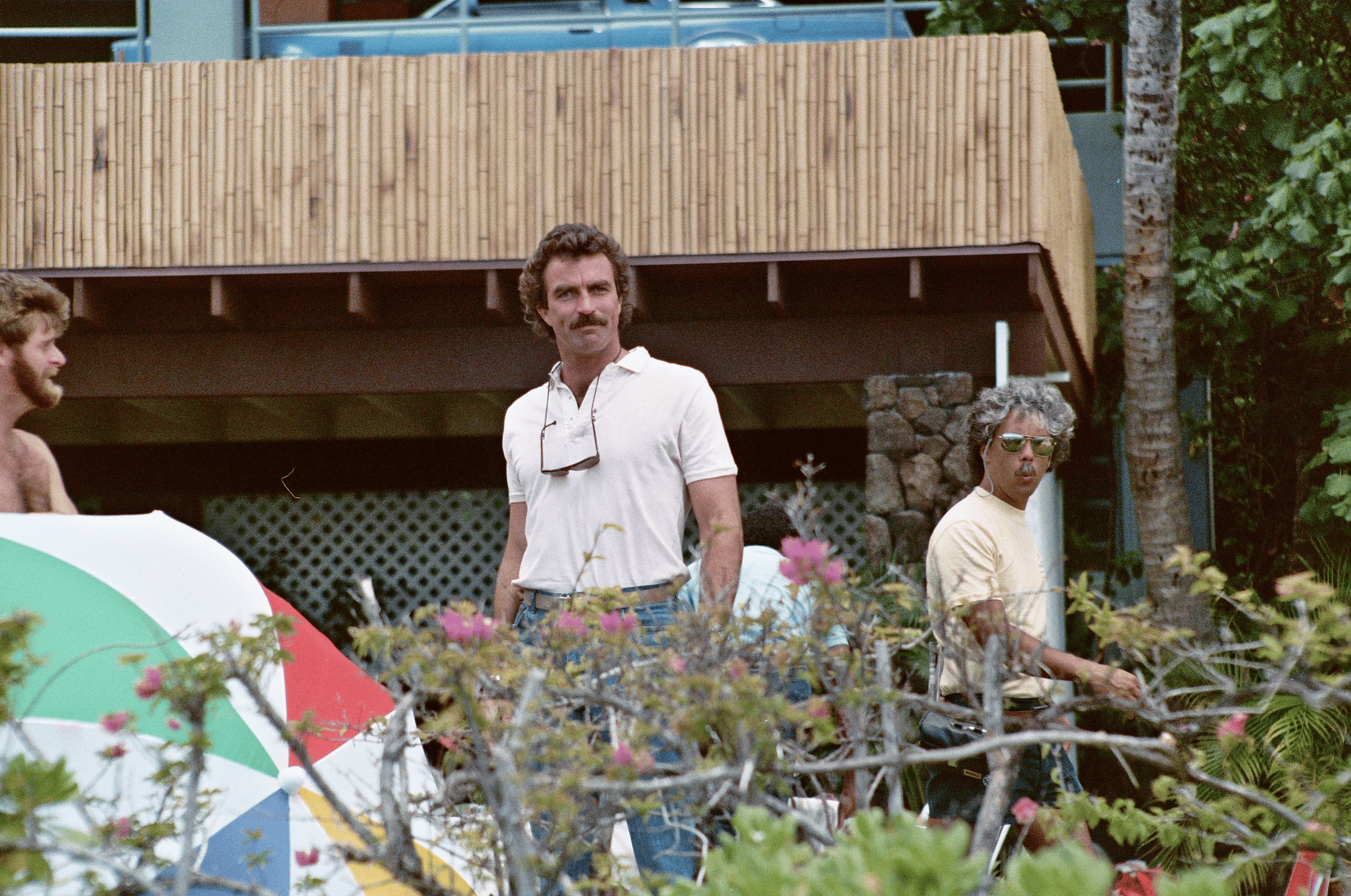
3. Haleakala National Park
We’re More Than Just Parks, but that doesn’t mean that we’ve forgotten about then entirely. At #3 on our list of the Best Hawaii Landmarks is Haleakala National Park.
Located on the island of Maui, Haleakala National Park is a feast for the eyes with two main areas to explore.
The crater is all the rage and has been deemed “the greatest sunrise in the national parks” by many. The caveat is if you can beat the crowds (which are substantial and require a reservation) AND get lucky with the weather.
Seeing the sunrise at the crater requires an advance permit.
The other section is the more tropical side (near Hana) with jaw-dropping waterfalls, ocean, palm trees, and rain forest.
The name Haleakala is Hawaiian for “House of the Sun.” In Hawaiian mythology, a god named Maui climbed the mountain and lassoed the Sun’s rays to lengthen the day.

Polynesians From The Marquesas Islands Were The First Humans To Visit & Settle The Hawaiian Islands
According to the National Park Service, Polynesians from the area now known as the Marquesas Islands were the first humans to visit and settle the Hawaiian Islands between 1000- 1200 AD.
These people were observers of natural phenomenon such as the stars, migratory birds, ocean currents, rainbows, and whales. The Polynesians crossed over 2,000 miles of ocean in double-hulled canoes called “Waʻa.”
These voyagers were not alone. They also brought along many animals and plants to help sustain them at their new homes: puaʻa (pigs), ʻilio (dogs), and moa (chickens); the roots of kalo (taro) and ʻuala (sweet potato); the seeds and saplings of niu (coconut), maiʻa (banana), ko (sugar cane), and other edible and medicinal plants.
The area that Haleakala National Park now encompasses has been a destination for many people since Polynesian’s first arrived in the Hawaiian Islands more than a thousand years ago.
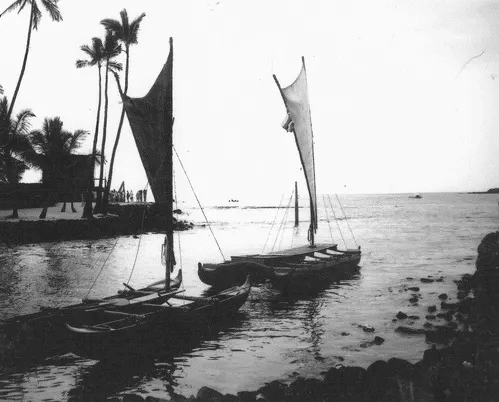
Things To Do
1. Haleakala Crater Summit
Unless you live in Hawaii getting to this tropical paradise is going to require hopping on a plane for more than a few hours.
Flights to Hawaii vary in price throughout the year and many domestic airlines offer some very competitive rates so you don’t have to break the bank to make this happen.
Haleakala Crater Summit When we say the summit we mean the summit. Atop Haleakalā is an observatory, parking area, and a few trailheads.
From this area at sunrise or sunset you can take in some of the most spectacular views in the entire national park system.
Perched high above the clouds the Haleakalā Summit offers a commanding view of the island of Maui and the pacific ocean far below.
On a good day a sunrise or sunset here will be one that you’ll never forget.
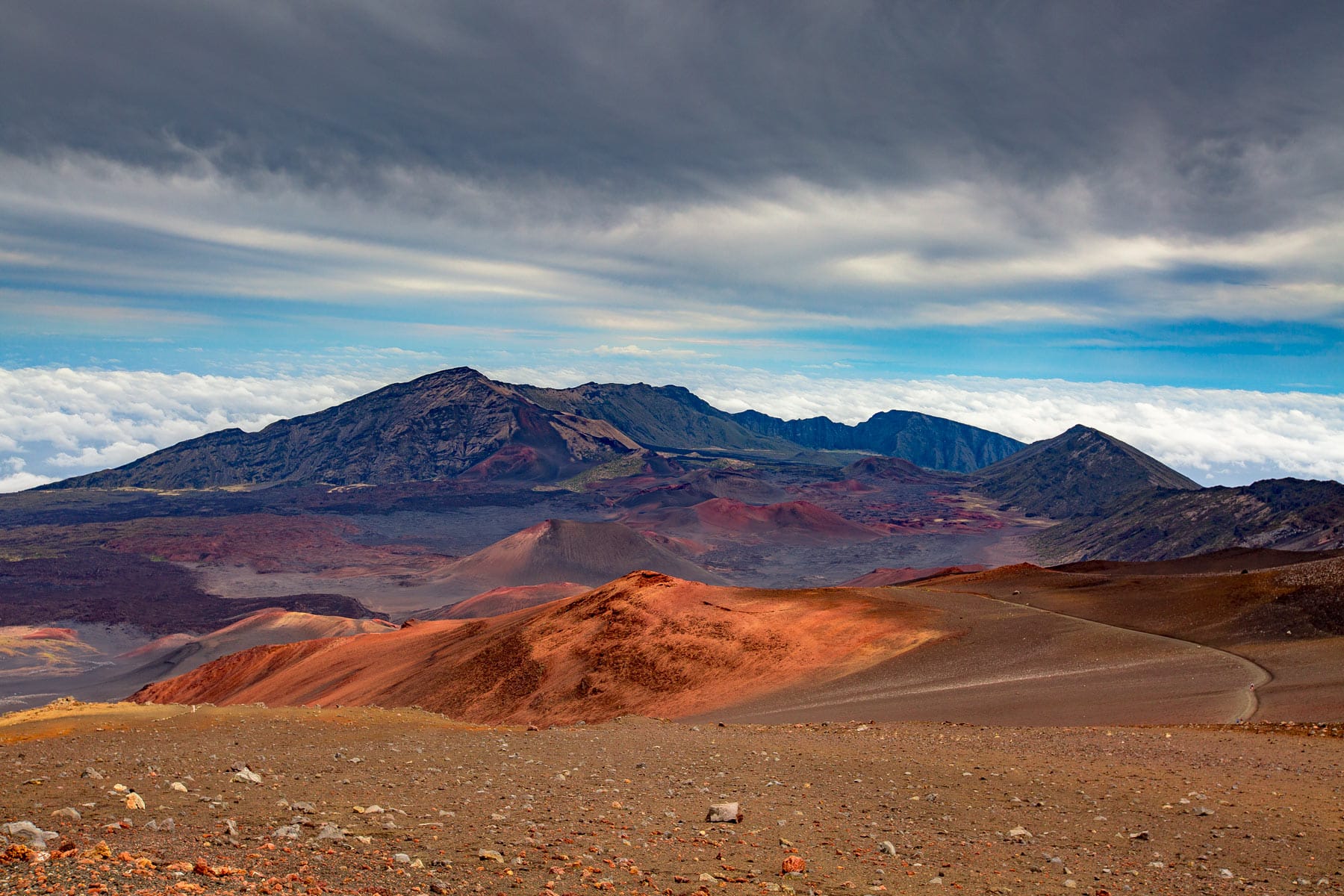
2. The Road to Hana
The Road to Hāna, also known as the Hāna Highway is a narrow, one-lane, winding, scenic road that takes drivers through some of the most beautiful areas of Hawaii.
The road is definitely not for the faint of heart as it’s as famously narrow and dicey as it is beautiful.
If you’re renting a car and feel confident enough you just have to brave the Road to Hāna. It’s something you’ll be telling friends about for years to come.
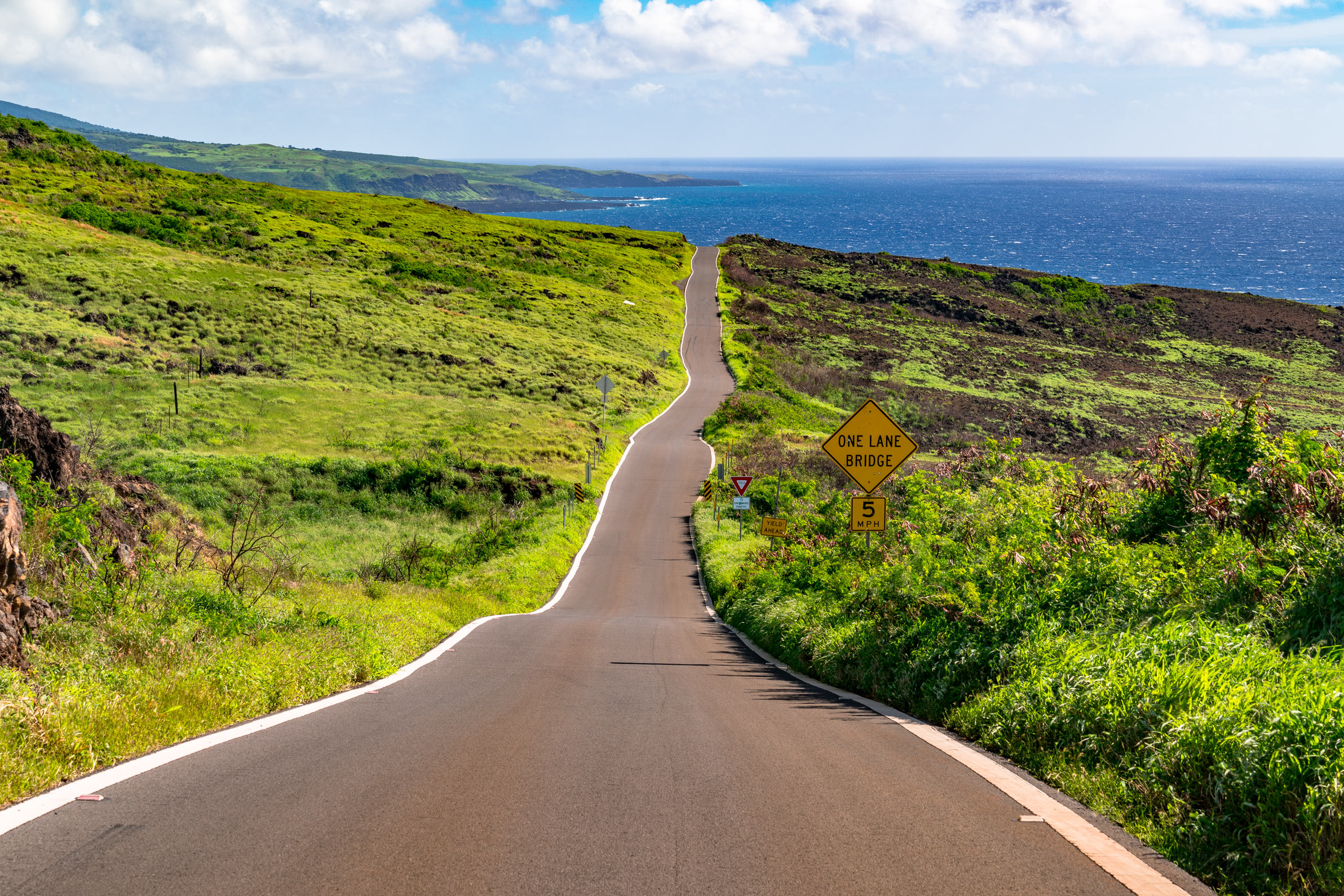
3. Waimoku Falls & Pipiwai Trail
Waimoku Falls Cascading some 400 feet down to the forest floor is the beautiful Waimoku Falls in the Kīpahulu area of the park.
The falls can be accessed 2 miles into the 4-mile roundtrip Pīpīwai Trail.
This trail which provides hikers with beautiful views of various waterfalls, streams, and various other natural features.
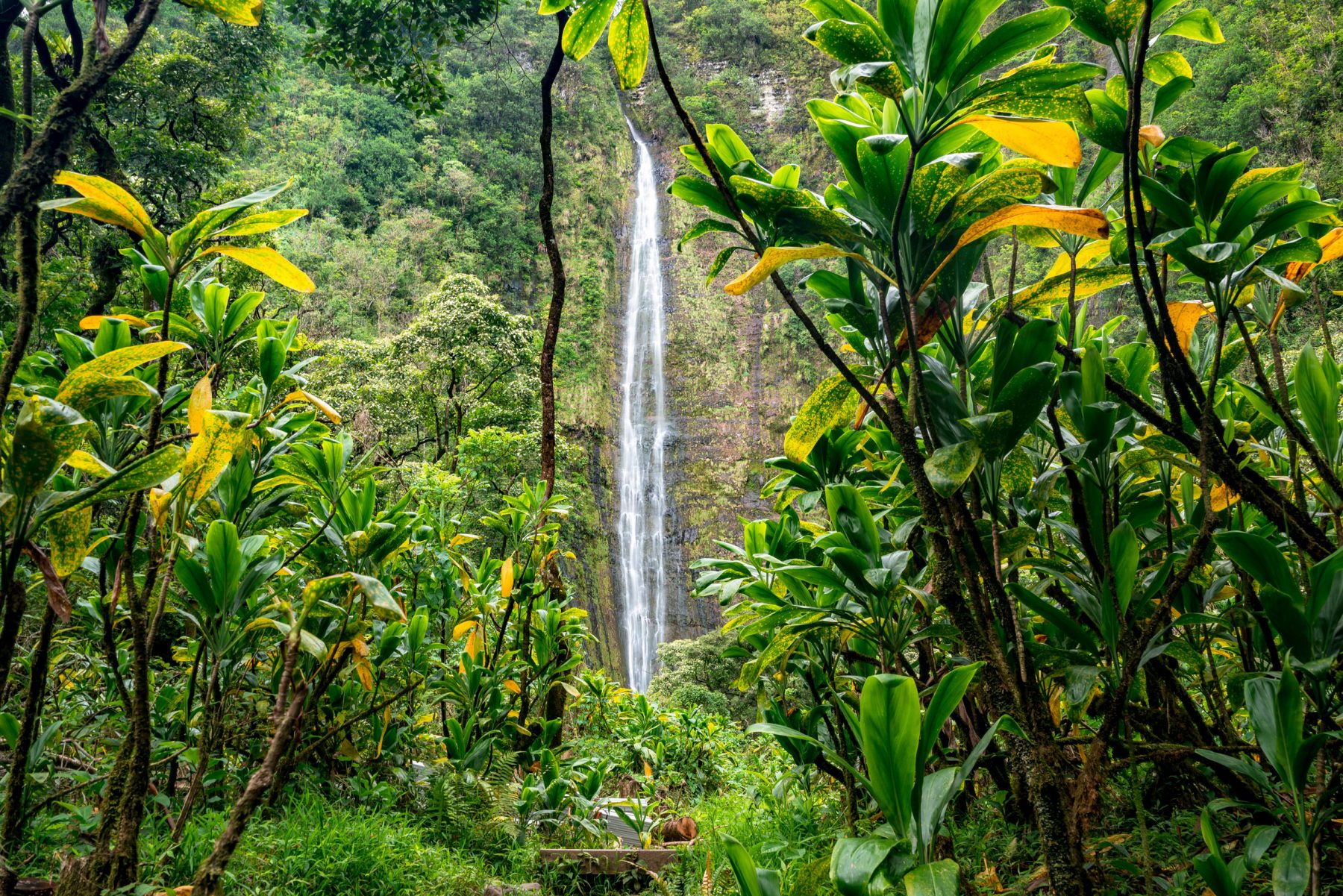
4. Bamboo Forest
Bamboo Forest About 1 mile in the Pīpīwai Trail gives way to a boardwalk that cuts through the heart of a vast bamboo forest, the likes of which you have never seen.
The bamboo reaches soaring heights and hearing the rustle of the chutes in the wind is quite a treat. We definitely recommend it.
For more, check out our Things To Do Haleakala post.
Check Out Our Haleakala National Park Video
HALEAKALA 8K is the culmination of several weeks and multiple trips to the remote outer reaches of the island of Maui in the Central Pacific. Journey with us to the house of the sun and discover ancient volcanoes steeped in legend, rugged mountains, dense rainforests, hidden beaches, underwater worlds, and the last wild home to spectacular wildlife. This is Haleakalā. Filmed primarily in 8K.
For this film we hiked every trail in the park and spent multiple seasons on the island of Maui. Haleakala is only one of six “tropical” National Parks in the system. The others are: Virgin Islands, Key Biscayne, American Samoa, Dry Tortugas, & Hawai’i Volcanoes.
Haleakala is unique because of it’s mix of ancient volcanic features in Haleakala Crater & it’s rugged, tropical coastline. Two standout locations in the park are Haleakala Crater which features one of the most beautiful (and popular) sunrises in the entire National Park system and the Pipiwai Trail to Waimoku Falls which is one of the most beautiful hikes in the entire system.
2. Hawaii Volcanoes National Park
We’re on to our final 2 landmarks. In the runner-up spot at #2 is another national park. It’s Hawaii’s flagship national park – Hawai’i Volcanoes.
As a matter of fact, it used to encompass Haleakala National Park on the neighboring island of Maui as well.
Despite that subtraction the place is otherworldly (very mars-esque) and presents a rare opportunity to see lava (or at least it’s effects depending on whether it’s active during your visit) up close.
The park protects some of the most unique geological, biological, and cherished cultural landscapes in the world.
Extending from sea level to 13,681 feet, the park encompasses the summits of two of the world’s most active volcanoes – Kīlauea and Mauna Loa.
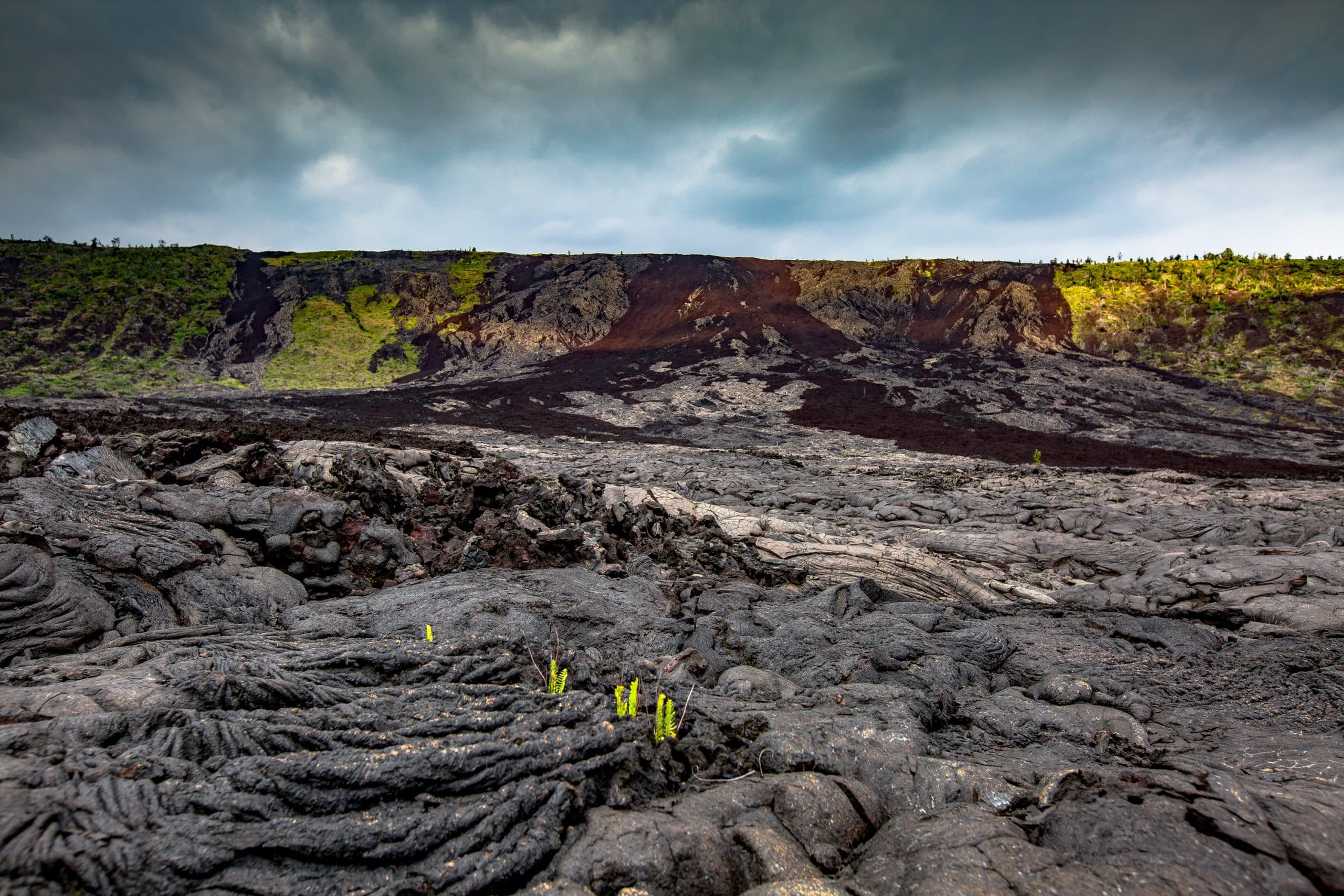
The Earliest Settlers Established A Caste System
For the inhabitants of the Hawaiian Islands, life was structured around a caste system.
The social heirarchy was delineated into a strict caste system. At the top of this social pyramid were rulers known as Aliʻ i (chiefs.)
On the next rung below the Aliʻ i were the Kahuna (professionals) who were experts on the spiritual realm, medicines, canoe-building, and rituals.
Below them were the Maka ʻainana (commoners) who farmed, fished, built homes, and paid taxes to the Aliʻi.
The lowest rung were the Kauwa (outcasts and slaves.) Kauwa were villagers who ran afoul of an Aliʻi or kahuna, or were war prisoners.
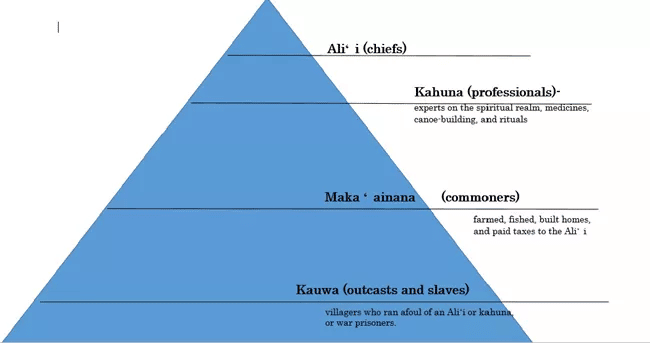
Things To Do:
1. Thurston Lava Tube
Thurston Lava Tube is a 500 year old lava tube located near the incredible Kilauea Crater in Hawai’i Volcanoes National Park.
This lava tube was carved out by a 2000F lava flow creating the subterranean cavern that exists today.
This hike through Thurston Lava Tube takes visitors through a lush tropical forest into the illuminated cavern below.
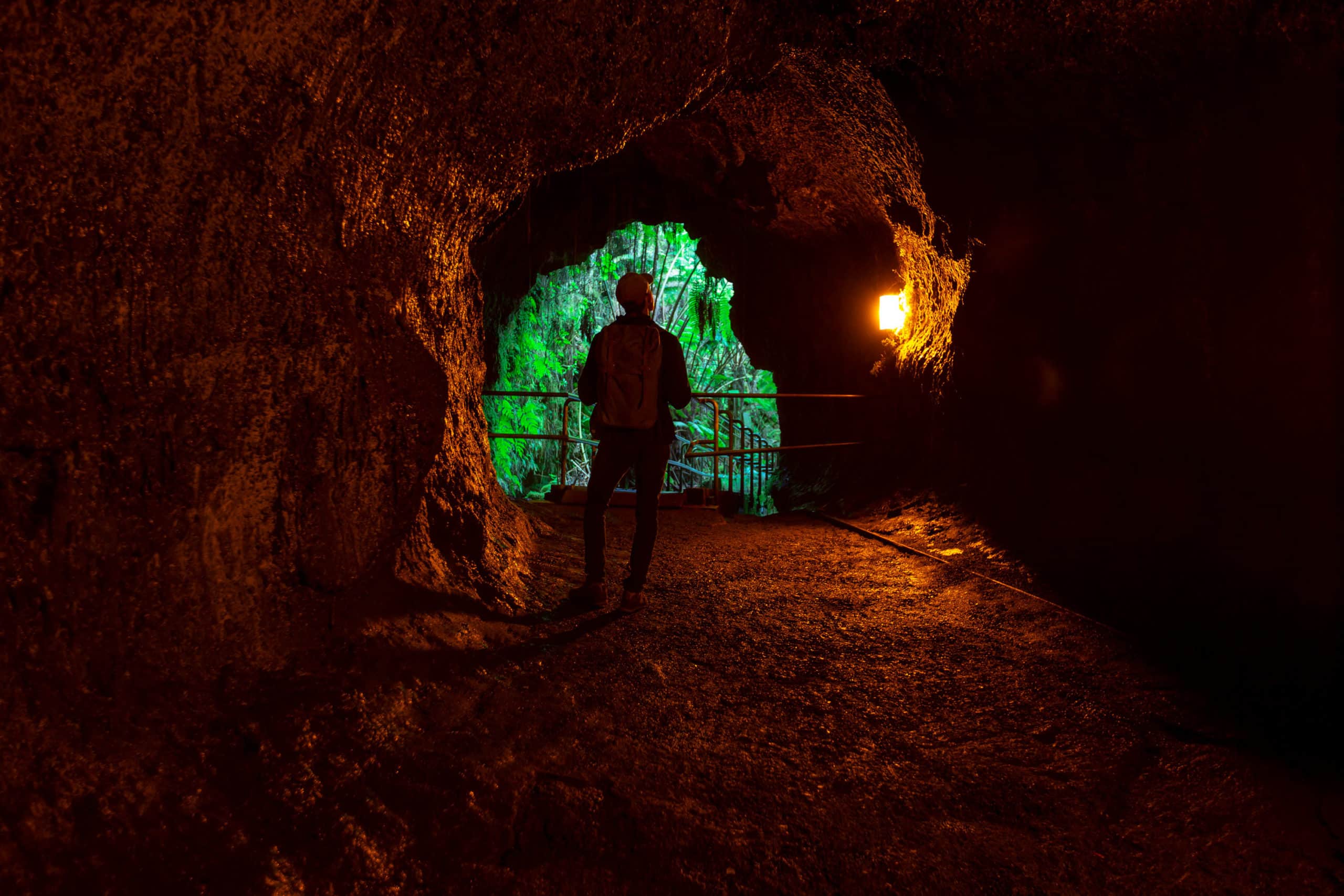
2. Kilauea Iki Crater
The Kilauea Iki Crater is a great spot for hikers to explore a crater at Hawaii Volcanoes National Park via the Kilauea Iki & Crater Rim Trails.
What was once a boiling lava lake is now a hardened surface for hikers to enjoy an afternoon in the park.
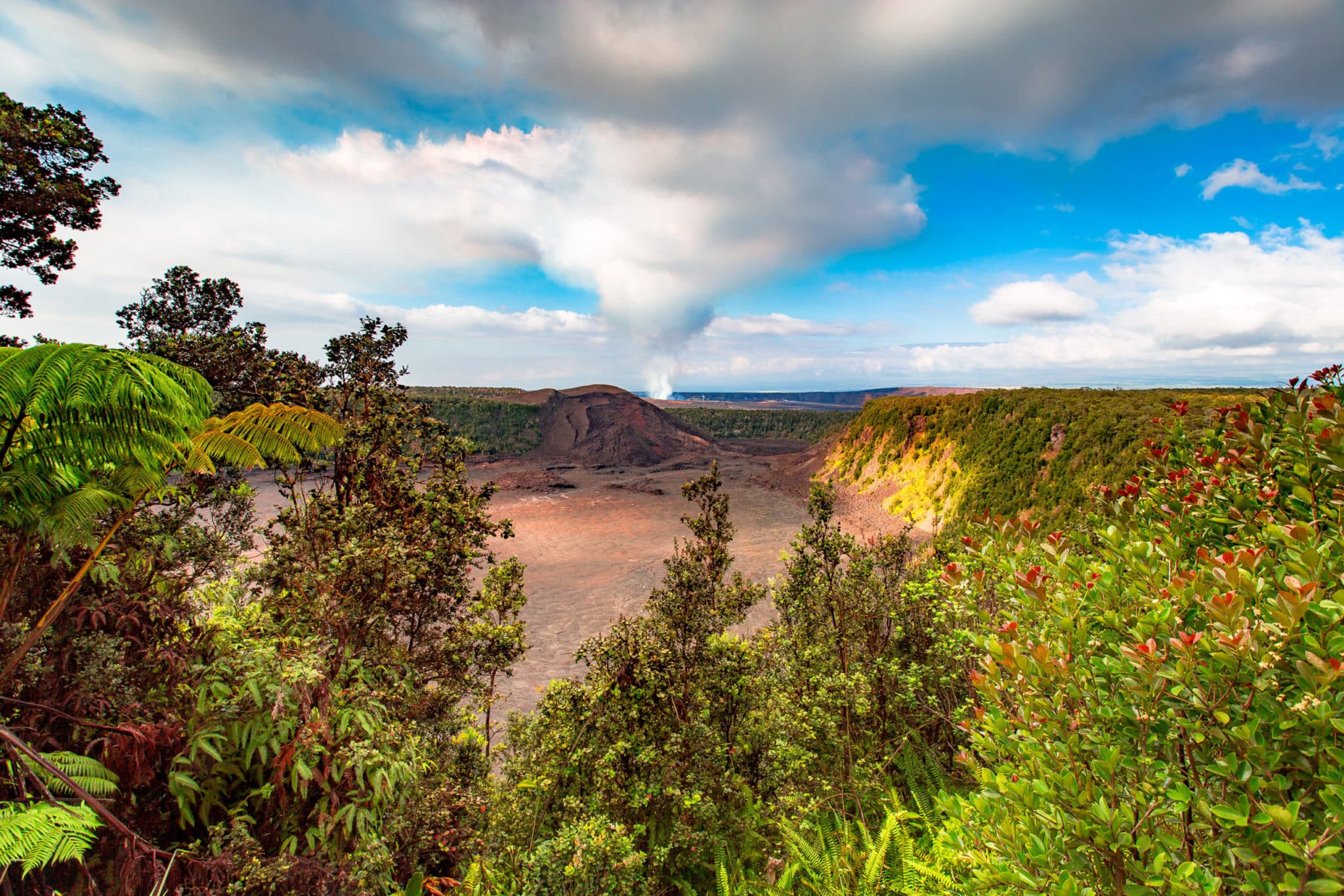
3. Pu`u Loa Petroglyphs
The Pu`u Loa Petroglyphs archeological site is a vast collection of over 23,000 petroglyphs located in Hawai’i Volcanoes National Park.
Given the amount of petroglyphs here, this site gives visitors an incredible opportunity to observe up close (without touching) an unbelievable array of petroglyphs dating back hundreds of years.
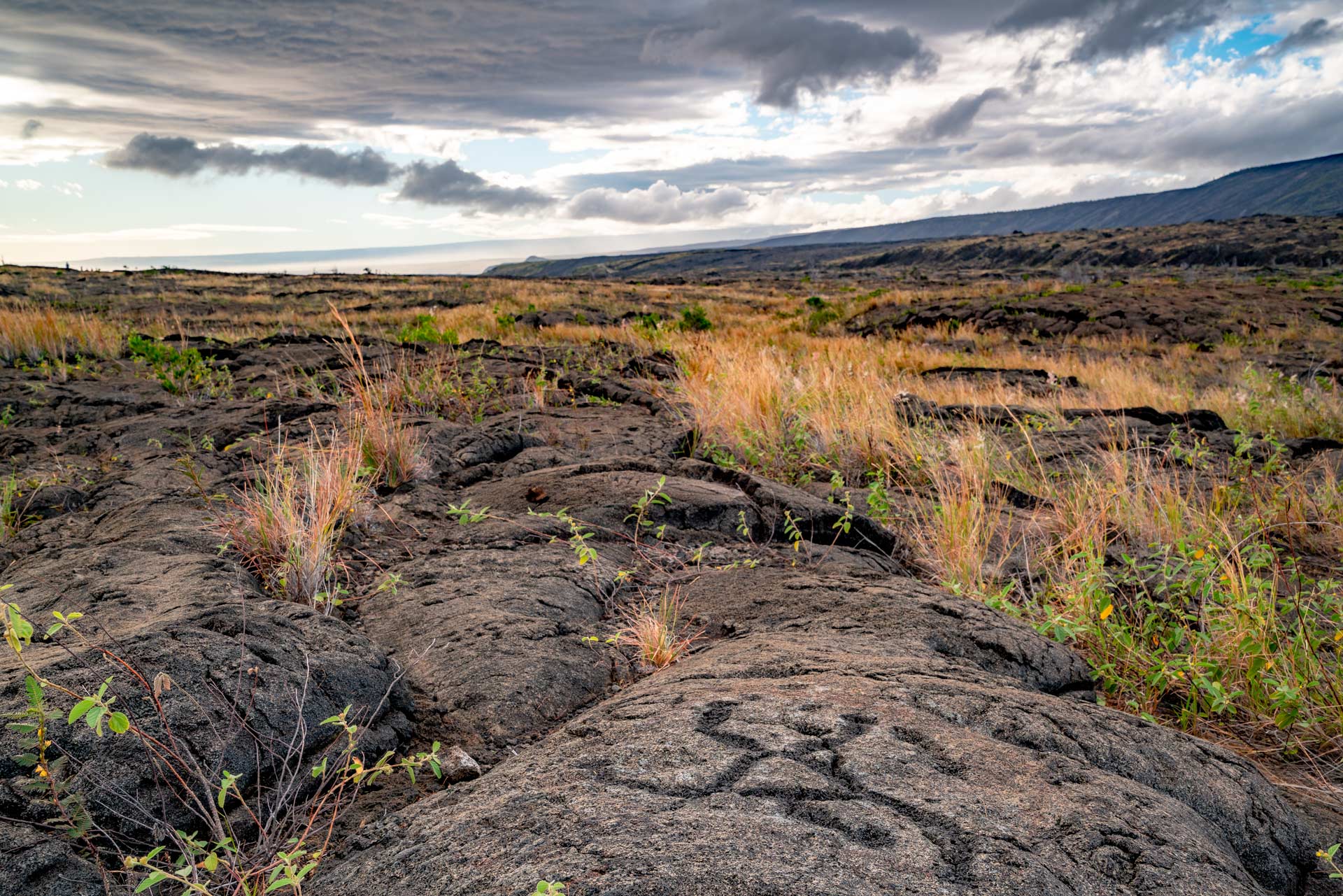
For even more things to do at Hawai’i Volcanoes National Park check out our 8 BEST Things To Do Hawai’i Volcanoes National Park post.
Check Out Our Hawaii Volcanoes Film
HAWAI’I VOLCANOES 8K is the culmination of several weeks spent filming in the rugged volcanic landscapes of Hawai’i Volcanoes National Park. Situated on the island of Hawaii in the heart of the remote south pacific, Hawai’i Volcanoes National Park boasts an awe-inspiring array of massive mountains, rare wildlife, and fiery volcanoes.
Journey with More Than Just Parks as we discover an ever-growing land shaped by fire. This is Hawai’i Volcanoes. Filmed primarily in stunning UHD 8K. Hawai’i Volcanoes National Park is an incredible place featuring the most active volcano in the world. Kiluea is constantly in a state of eruption.
This film was shot before much of the more recent explosive activity occurred and features some locations that have been significantly altered.
This park also features beautiful jungle-like forests and rugged coastline that are not to be missed. It is one of two Hawaii parks along with Haleakala on the island of Maui. Hawai’i Volcanoes is on the big island of Hawaii.
1. Pearl Harbor National Memorial
As our #1 Hawaii Landmark, More Than Just Parks has selected Pearl Harbor.
On December 7, 1941, over 350 Japanese aircraft attacked the US naval base in Pearl Harbor, Hawaii, destroying or badly damaging much of the US Pacific fleet and causing thousands of casualties.
President Franklin Roosevelt called it ‘a date that would live in infamy’.
Japan killed 2,403 Americans on Dec. 7, 1941. More than 400,000 U.S. soldiers would die in the four years that followed.
The attack unified a divided nation and led to U.S. participation in World War Two which proved to be decisive in defeating the fascist powers of Germany, Italy & Japan.
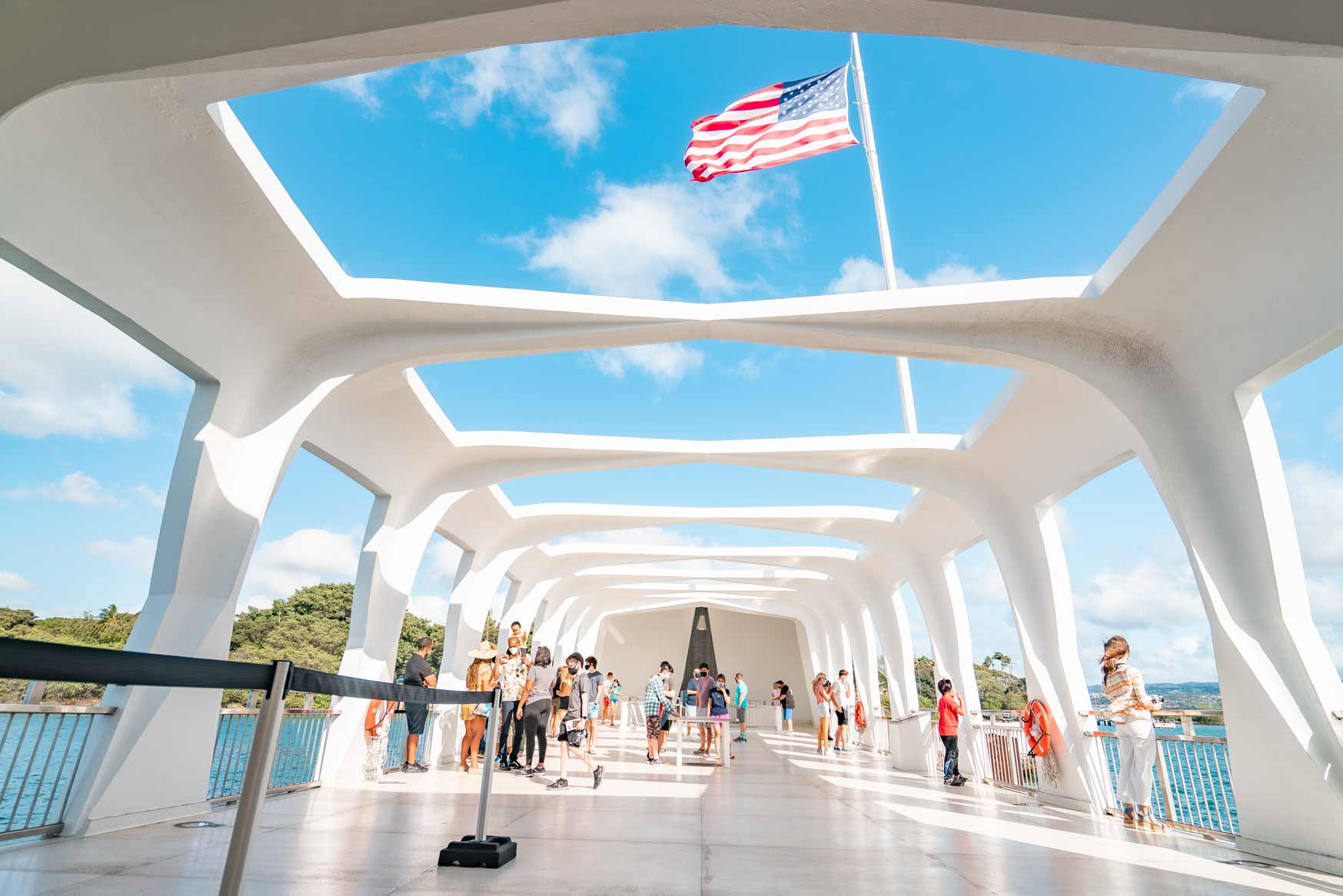
Four Unique Attractions
Today, Pearl Harbor remains an active military base, Headquarters of the Pacific Fleet, and a National Historic Landmark that’s home to four unique attractions.
These attractions include: the USS Arizona Memorial, the Battleship Missouri, the USS Bowfin Submarine Museum and Park and the Pearl Harbor Aviation Museum.
From the surprise attack on Pearl Harbor that started it all, to the surrender of the Japanese on the deck of the mighty Battleship Missouri, these four historic sites together tell the story of the War in the Pacific, commemorating the accomplishments of a previous generation.
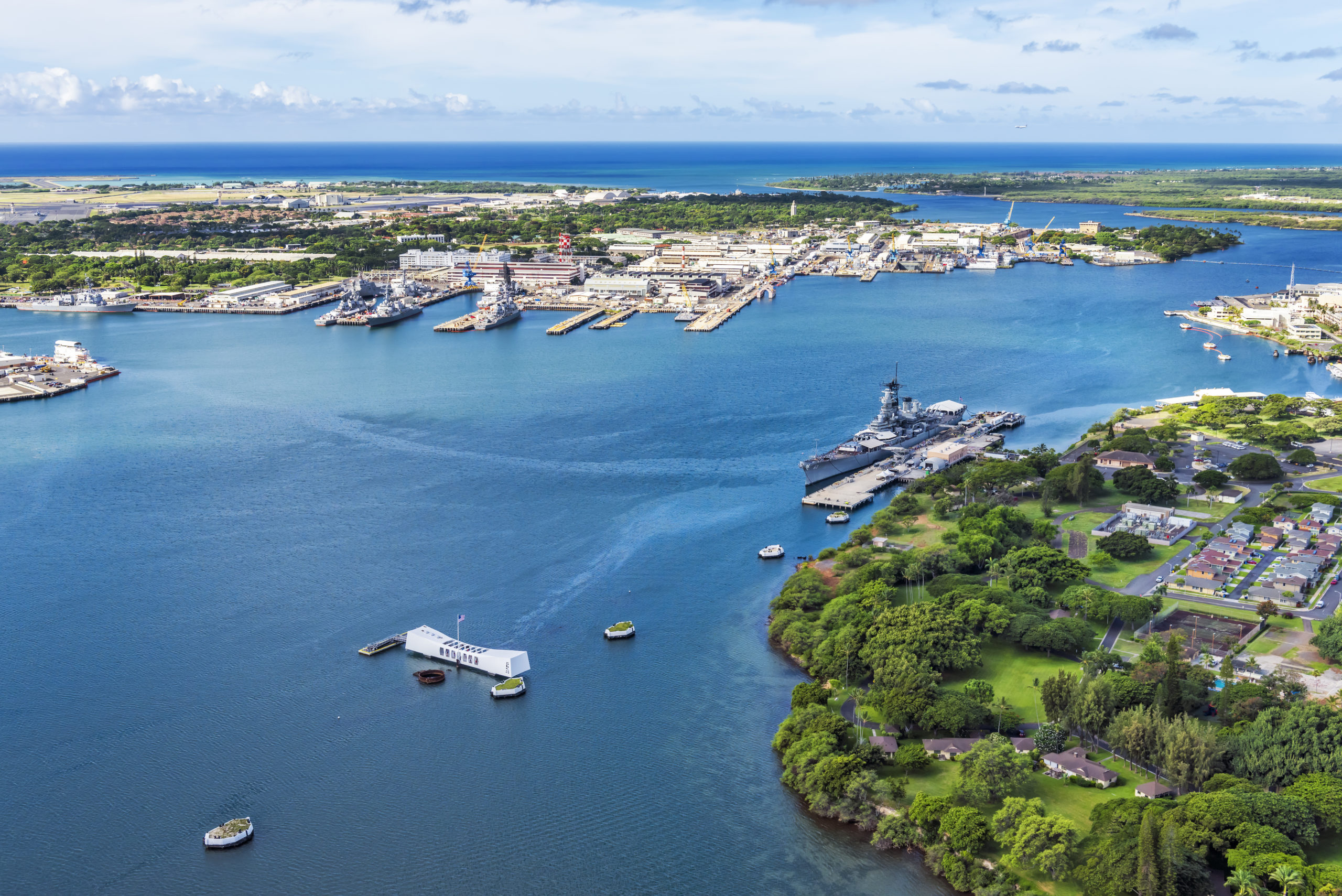
Recognizing The Sailors Who Served On The Arizona
On December 6, 1941, the Arizona returned to its base at Pearl Harbor. The next morning, at approximately 7:55 am, Japan launched a surprise attack on the naval base.
For nearly two hours, more than 350 Japanese aircraft—which included torpedo planes, bombers, and fighters—dropped bombs on U.S. vessels.
At approximately 8:10 am, the Arizona was struck by a 1,760-pound (800-kg) projectile. The impact caused munitions and fuels to ignite, creating a massive explosion that reportedly lifted the battleship out of the water. As it sank, the ship was struck by more bombs.
In addition, some claimed that the Arizona was also hit by torpedoes, though no evidence was found to support that assertion.
While 334 crew members survived—some sources give 355—the horrific death toll on the Arizona was 1,177.
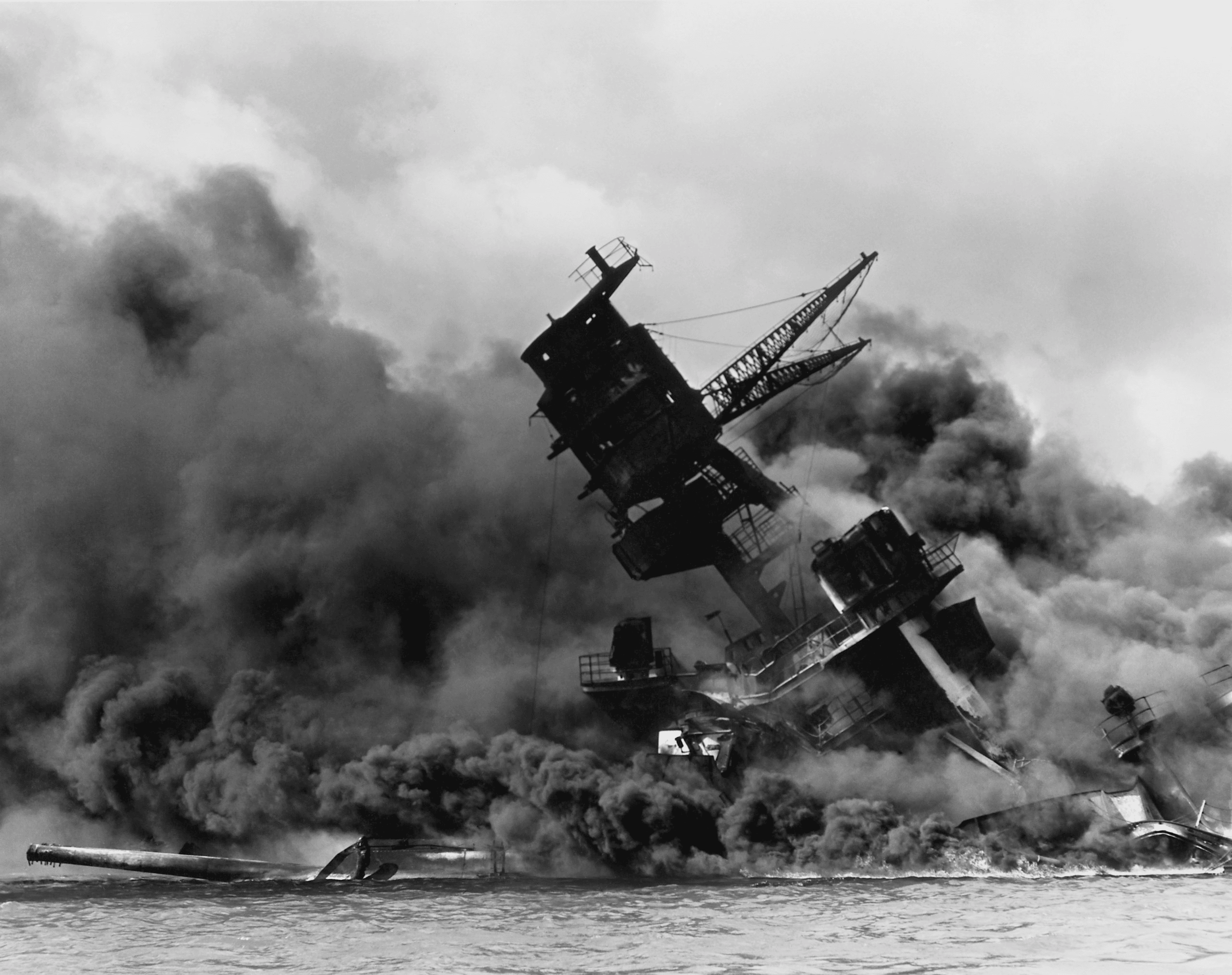
Things To Do At Pearl Harbor
Among the activities which I recommend are the following:
- Exhibit Galleries: “Road to War” and “Attack” Both of these exhibits are well worth the visit. I spent about 20 minutes at each one and found them fascinating. They detail the events leading up to and the attack on Pearl Harbor.
- Pearl Harbor Memorial Theater: If you’ve got the time there is a great 23 minute film to watch that take you inside the events of Pearl Harbor.
- Bookstore: Who doesn’t love a good bookstore? This one is really nice with some great books and souvenirs.
- Interpretive Wayside Exhibits: All throughout the
- Remembrance Circle: This exhibit pays tribute to the men, women, and children, both military and civilian, who were killed as a result of the attack on December 7, 1941. Medal of Honor recipients are noted with their names listed in gold lettering, and a bronze 3-D map of Oahu illustrates the various attack targets of that day.
- Boat Ride to the USS Arizona: This is was the highlight of the trip for me and for most. Visitors can take a boat operated by the US Navy out to the infamous site of the USS Arizona and memorial that has been erected over top of it. Talking is prohibited on the boat ride over to pay respect for those who paid the ultimate sacrifice there.
- More Pearl Harbor Historic Sites: The Battleship Missouri Memorial, Pacific Fleet Submarine Museum, and the Pearl Harbor Aviation Museum are separate sites not managed by NPS but still worth a visit.

Take A Deeper Dive Into The History Of Pearl Harbor
As a retired history teacher and lifelong history buff, I cannot conclude this article without making some book recommendations regarding Pearl Harbor.
The Japanese attack on December 7th, 1941, was a transformative event, not only in U.S. History, but in World History as well.
Overnight America went from an isolationist nation deeply divided over whether it should enter the Second World War into a nation committed to do whatever it took to win that war.
The significance of Peal Harbor was not that the American people were attacked, but that they came together and grew stronger.
I therefore have several book recommendations if you are interested in learning more about one of the most important historical events of all time. They include the following:
- Day of Infamy, 60th Anniversary: The Classic Account of the Bombing of Pearl Harbor by Walter Lord.
- At Dawn We Slept: The Untold Story of Pearl Harbor by Gordon W. Prange.
- Countdown to Pearl Harbor: The Twelve Days to the Attack by Steve Twomey.
- Pearl Harbor Ghosts : The Legacy of December 7, 1941 by Thurston Clarke.

Map Of Hawaii Landmarks
List Of Hawaii Landmarks
- Pearl Harbor National Memorial
- Hawaii Volcanoes National Park
- Haleakala National Park
- Iolani Palace
- National Memorial Cemetery of the Pacific
- Aloha Tower
- Kalaupapa National Historical Park
- Shangri La Museum of Islamic Art, Culture & Design
- Pu’u O Mahuka Heiau
- Pu’uhonua o Honaunau National Historical Park
- Honolulu Zoo
- Polynesian Cultural Center
- Honolulu Museum of Art
- Dole Plantation
- Kīlauea Lighthouse
Why Trust Us About Hawaii Landmarks?
We’re Jim Pattiz and Will Pattiz, collectively known as the Pattiz Brothers and we absolutely LOVE the national parks.
You should probably know that we don’t just make this stuff up out of thin air. We’ve spent our entire adult lives exploring and filming America’s national parks and public lands.
We’ve worked with the National Park Service, the Department of Interior, USDA, U.S. Forest Service, and more for years creating films on important places and issues. Our work has been featured in leading publications all over the world and even some people outside of our immediate family call us experts on the national parks.
And, in 2018, our father – having spent a lifetime teaching history – joined us so that he could help us to tell the stories behind these amazing places.
Meet The Parks Brothers
We Hope You’ll Follow Our Journey

Our goal here at More Than Just Parks is to share the beauty of America’s national parks and public lands through stunning short films in an effort to get Americans and the world to see the true value in land conservation.
We hope you’ll follow our journey through the parks and help us to keep them the incredible places that they are. If you’re interested in joining the adventure then sign up below!
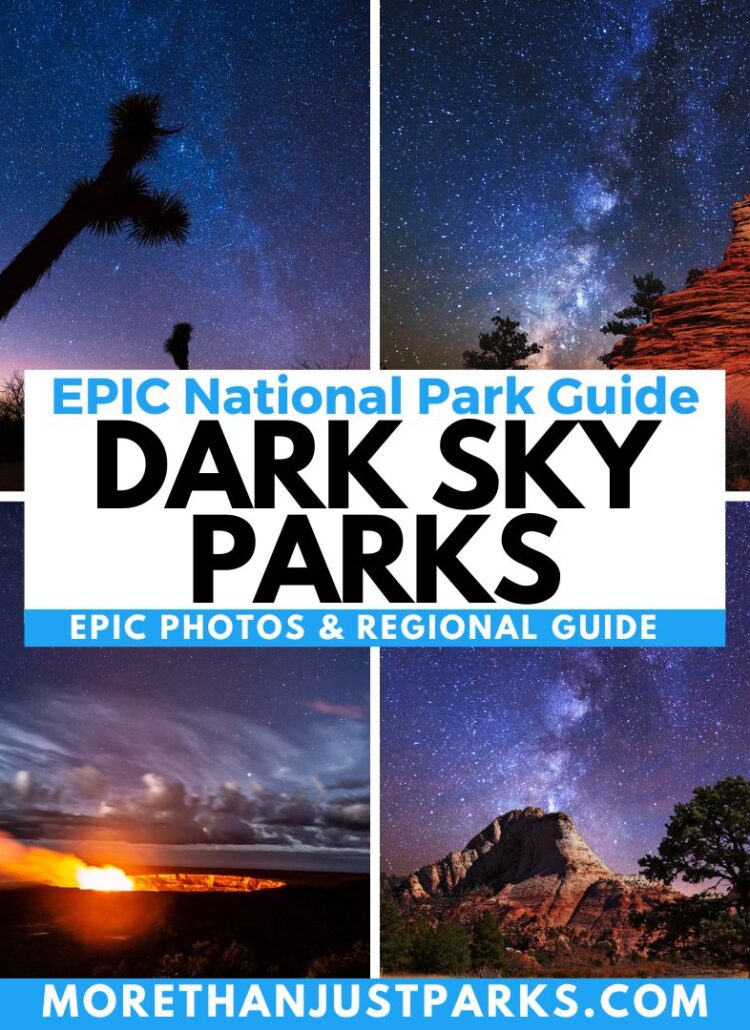
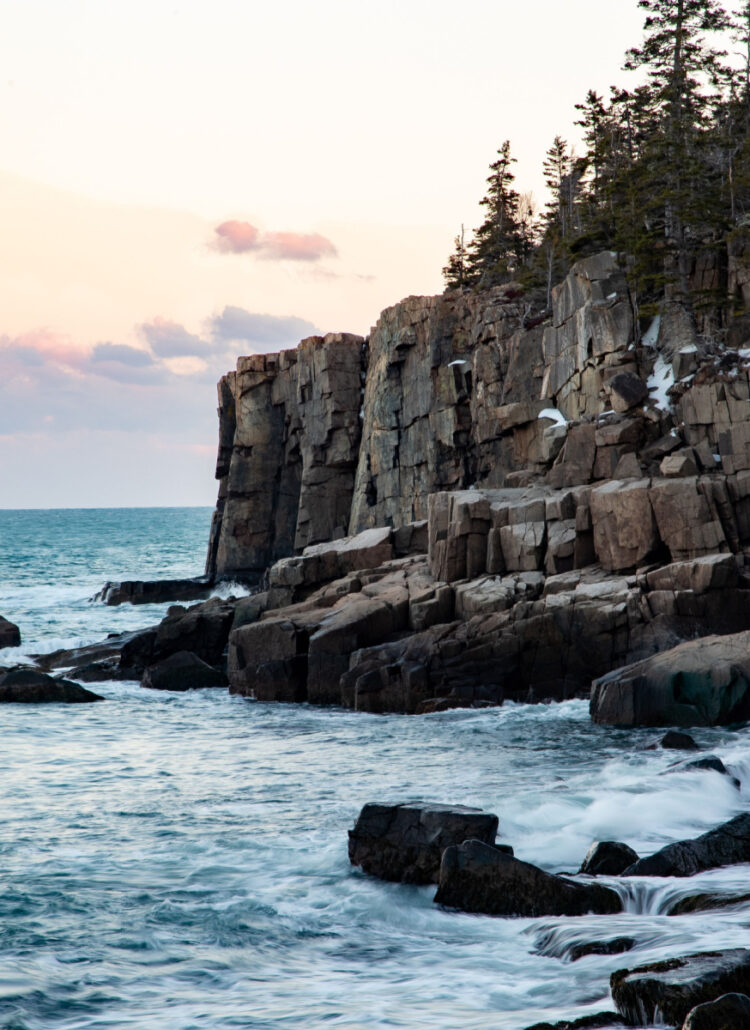
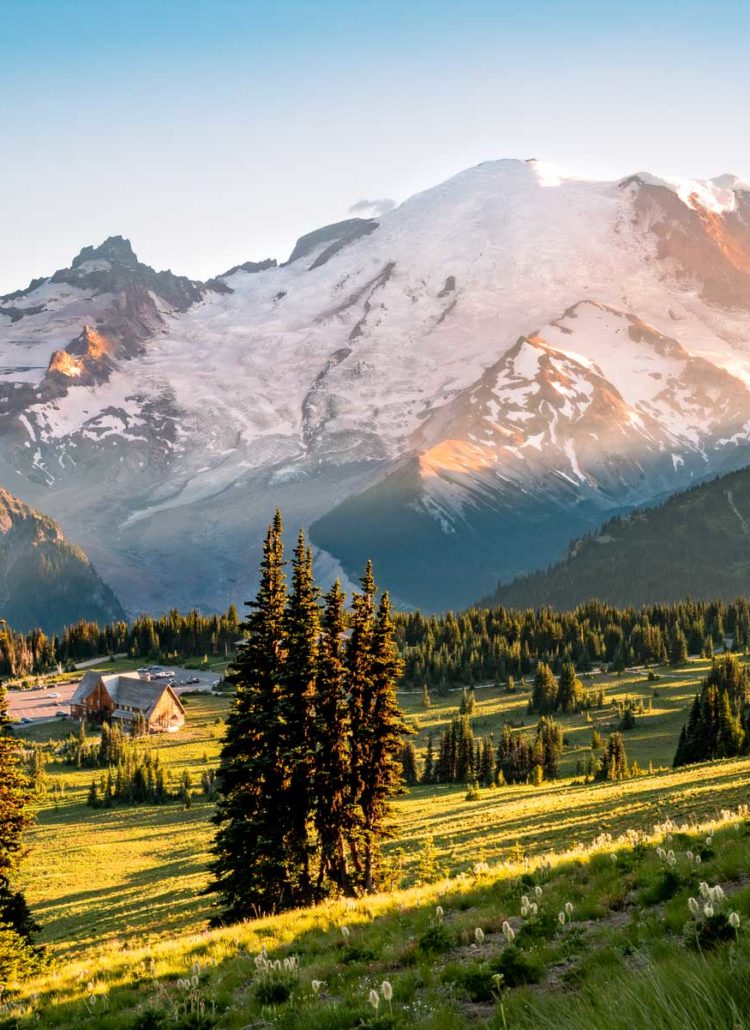
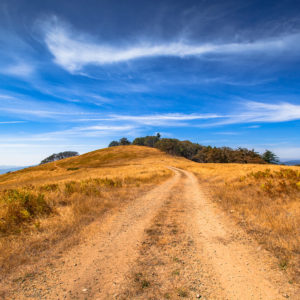

Leave a Reply